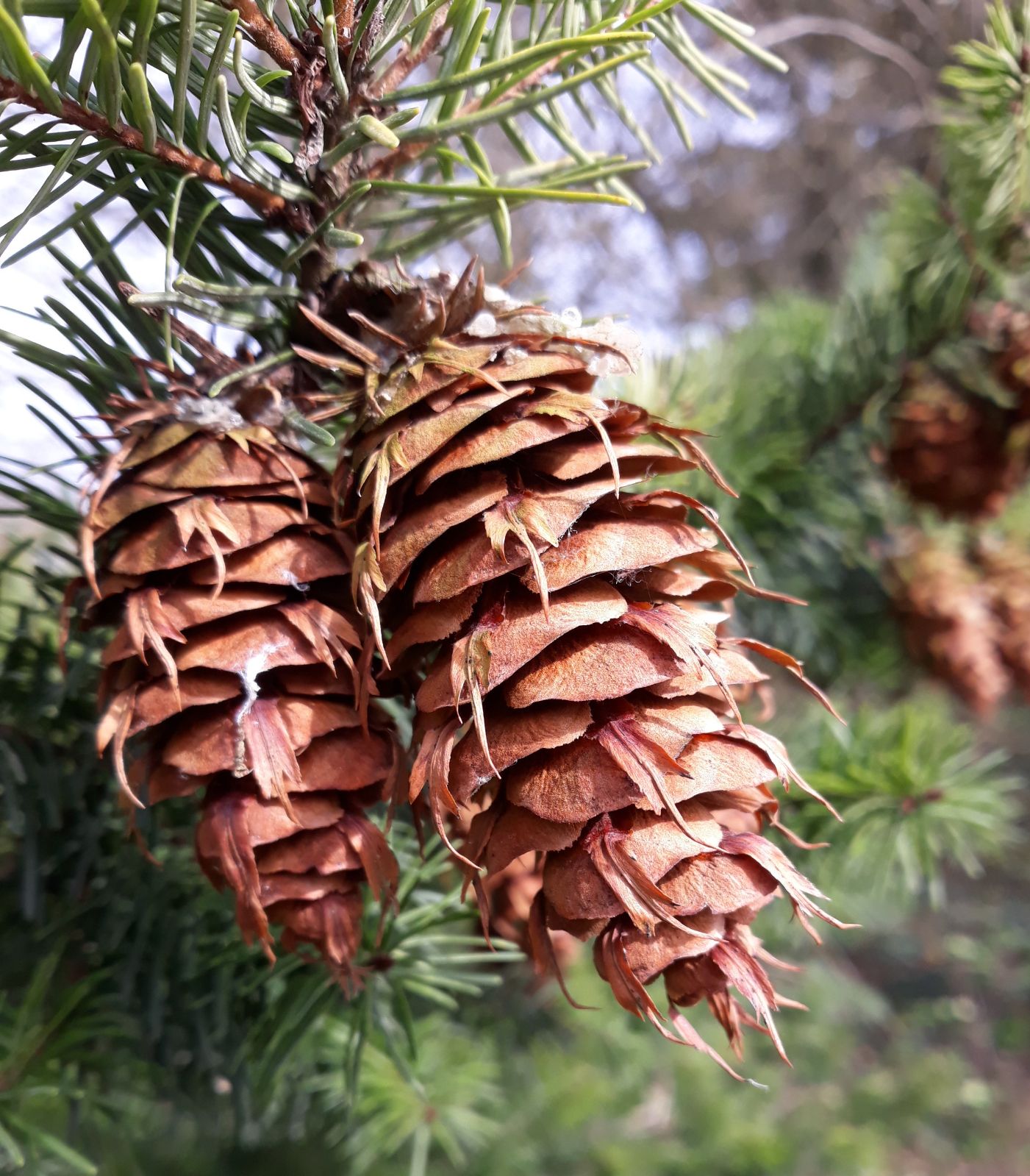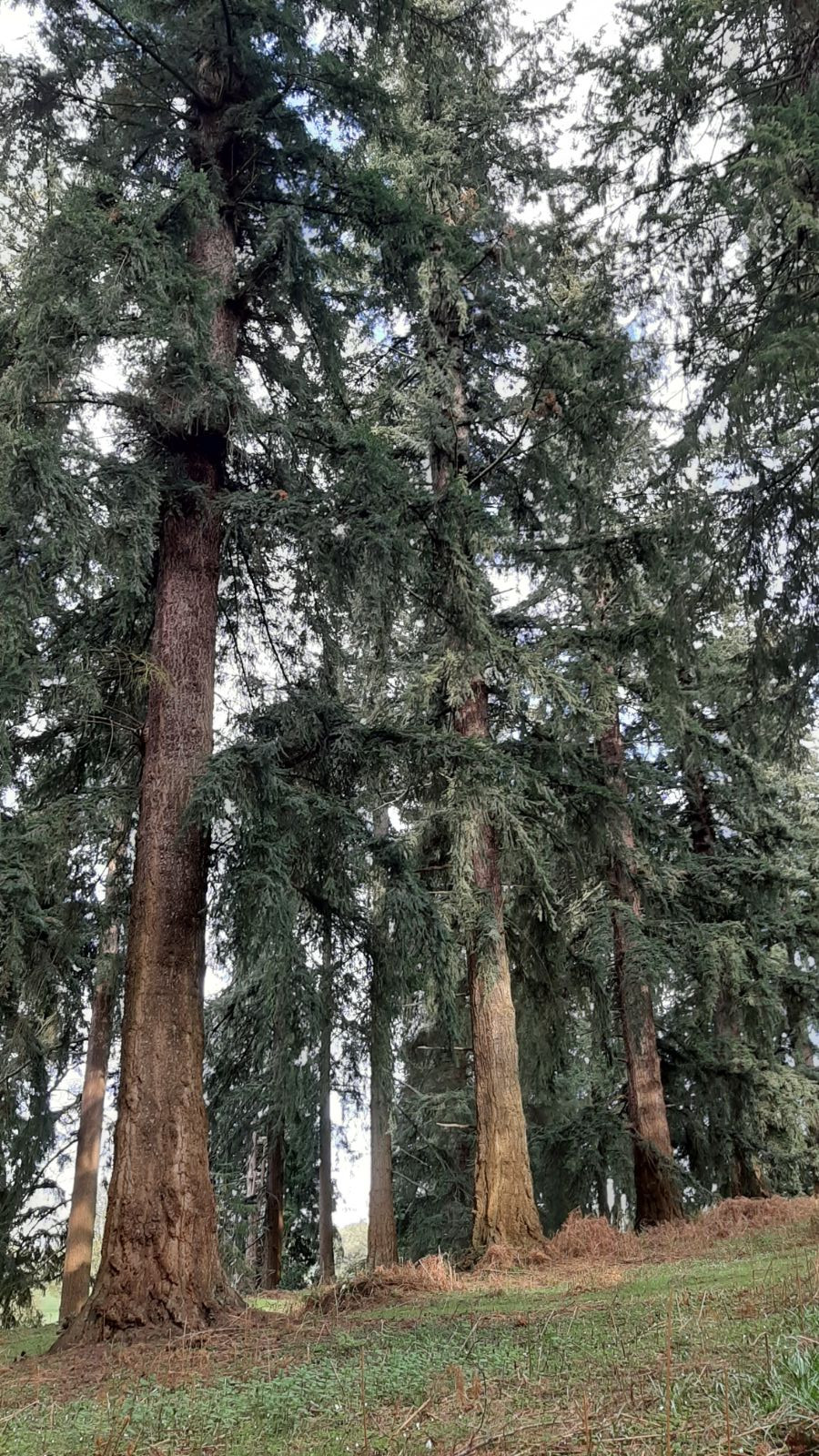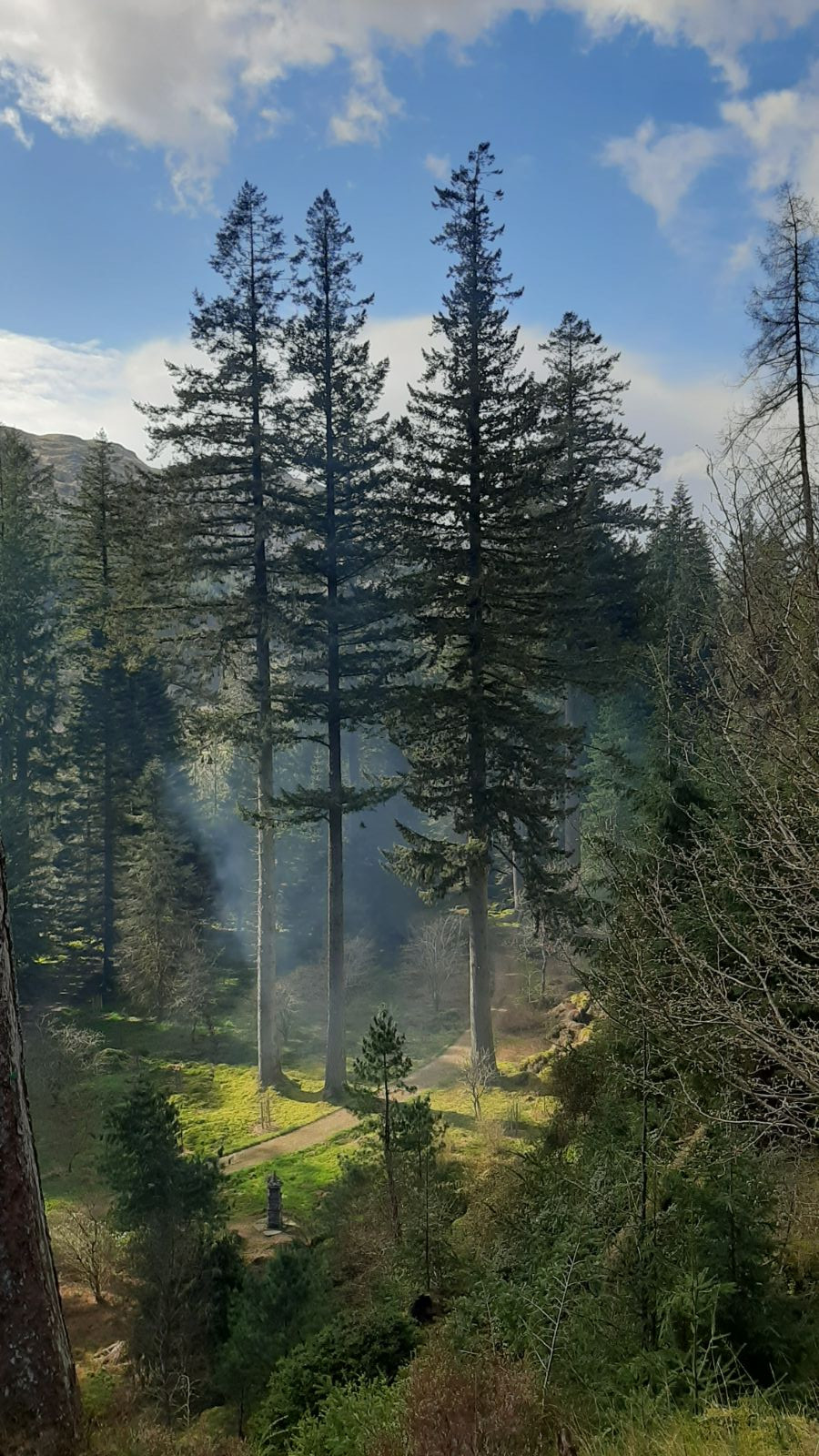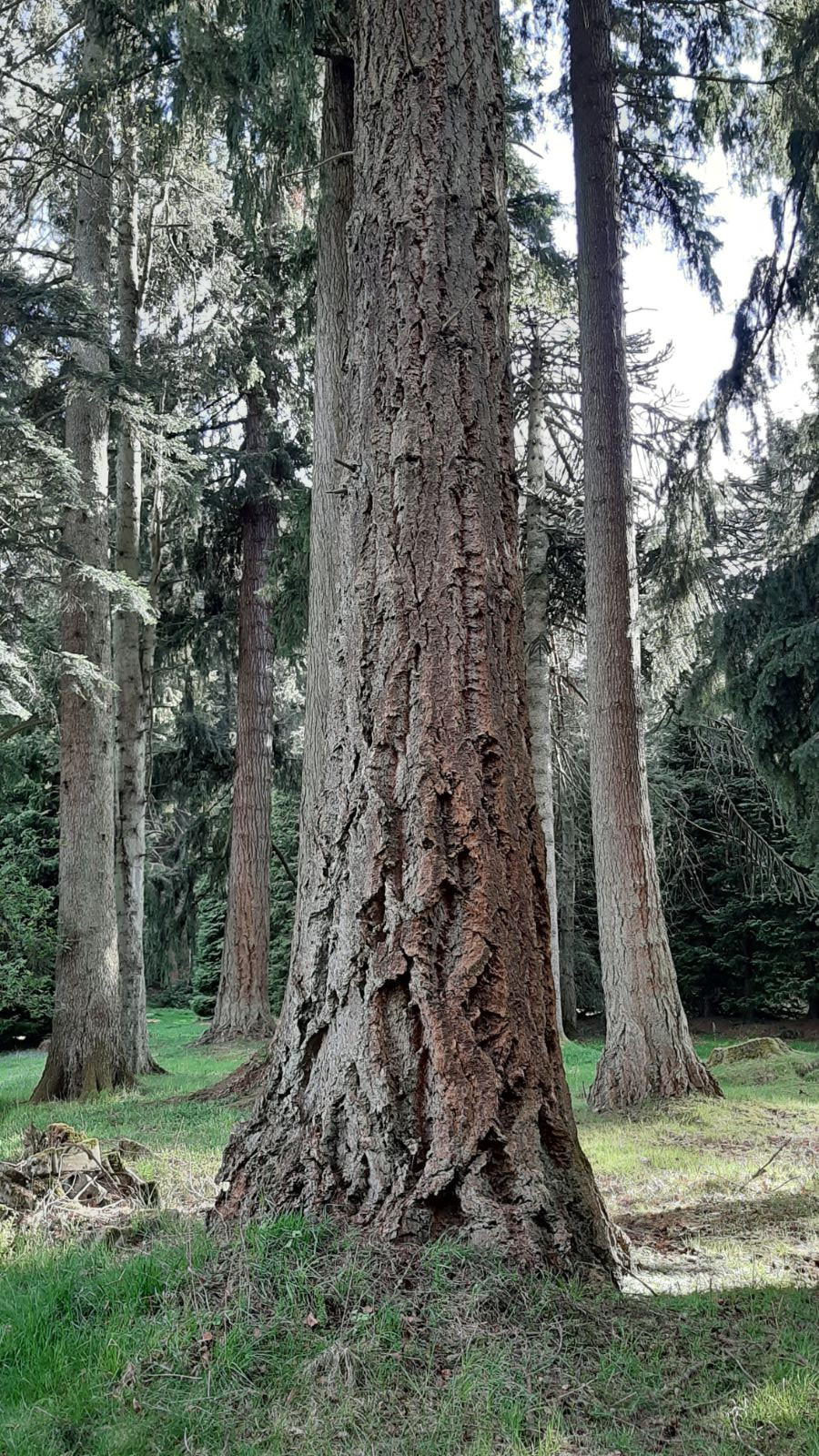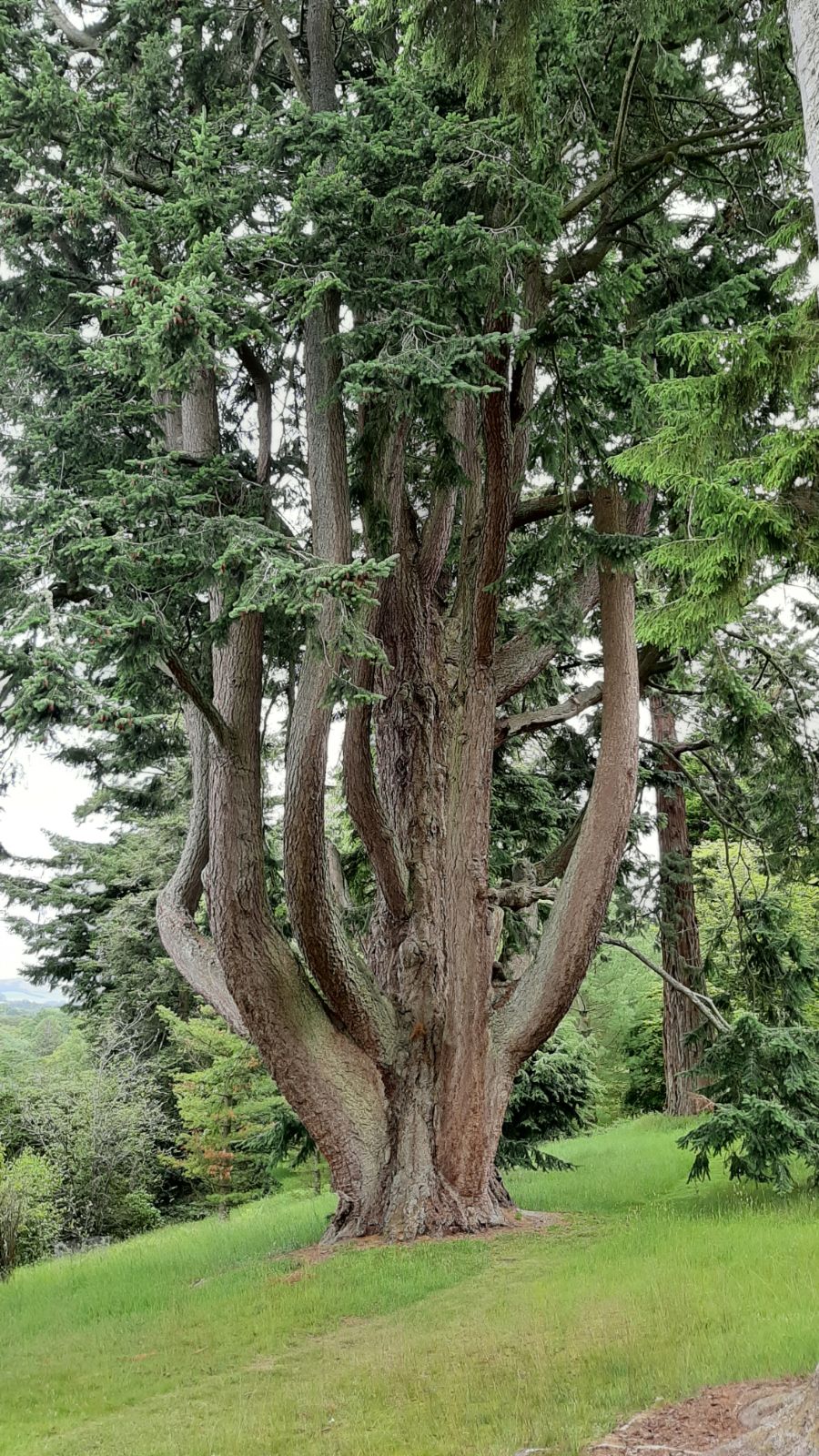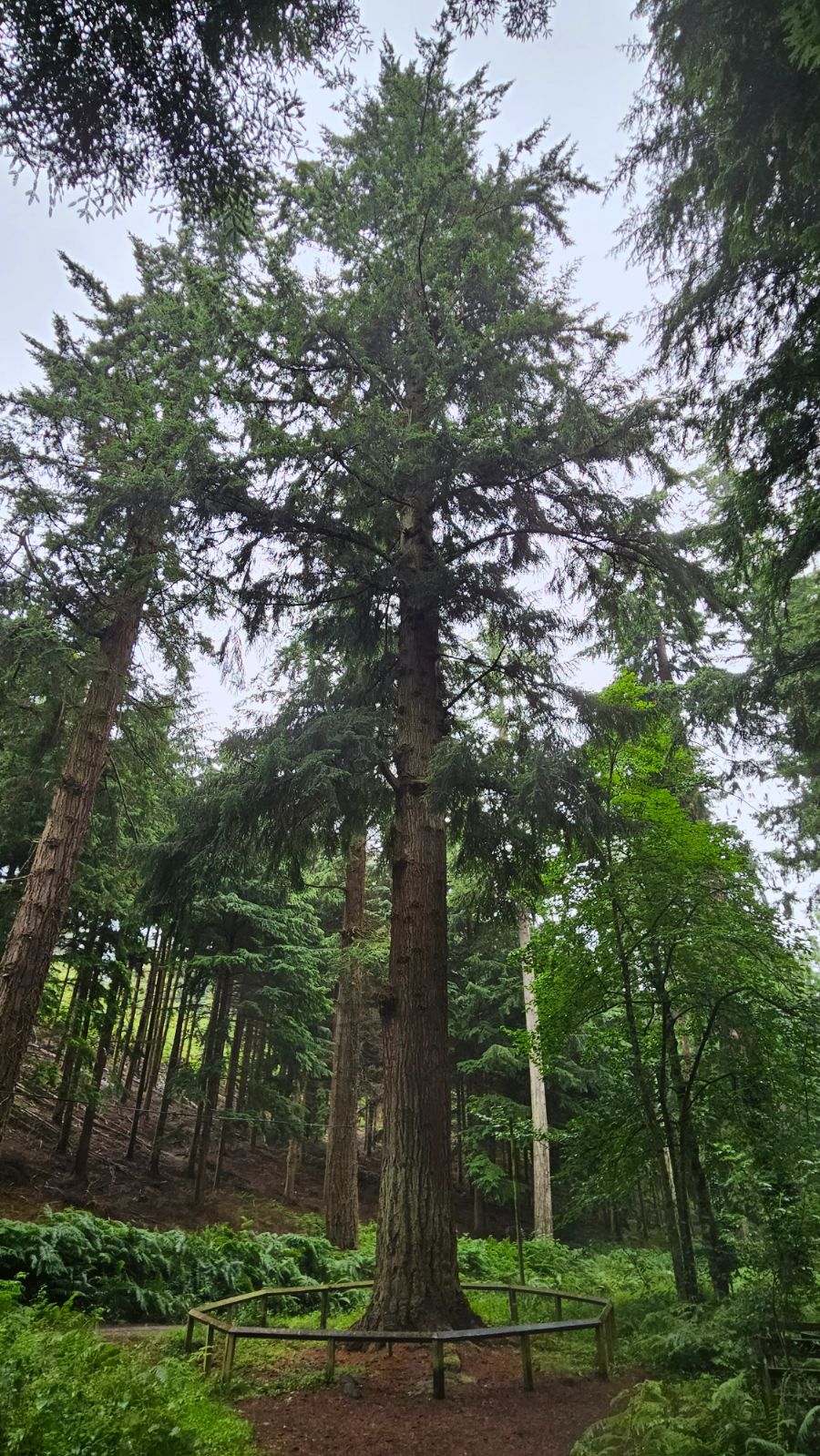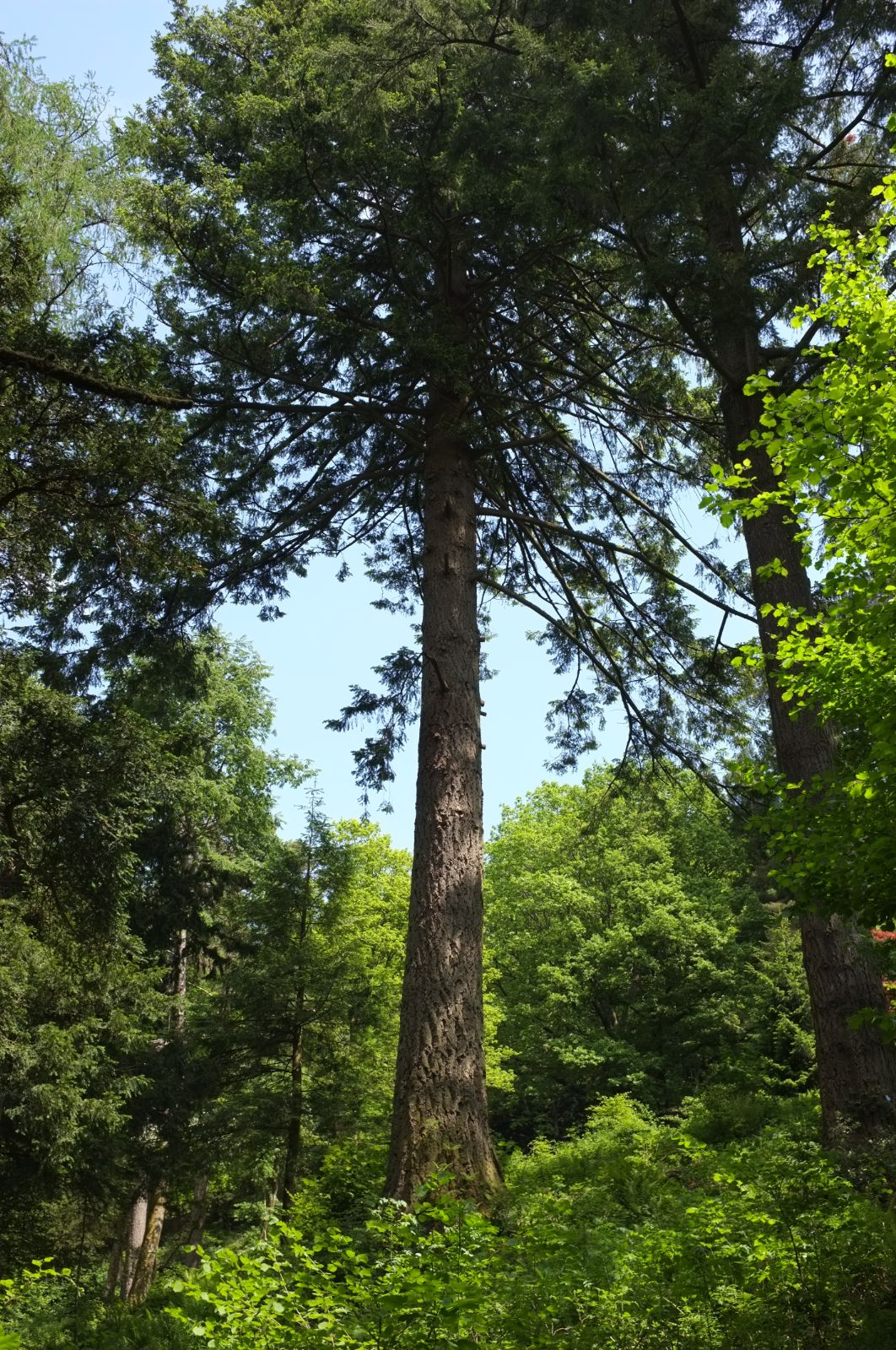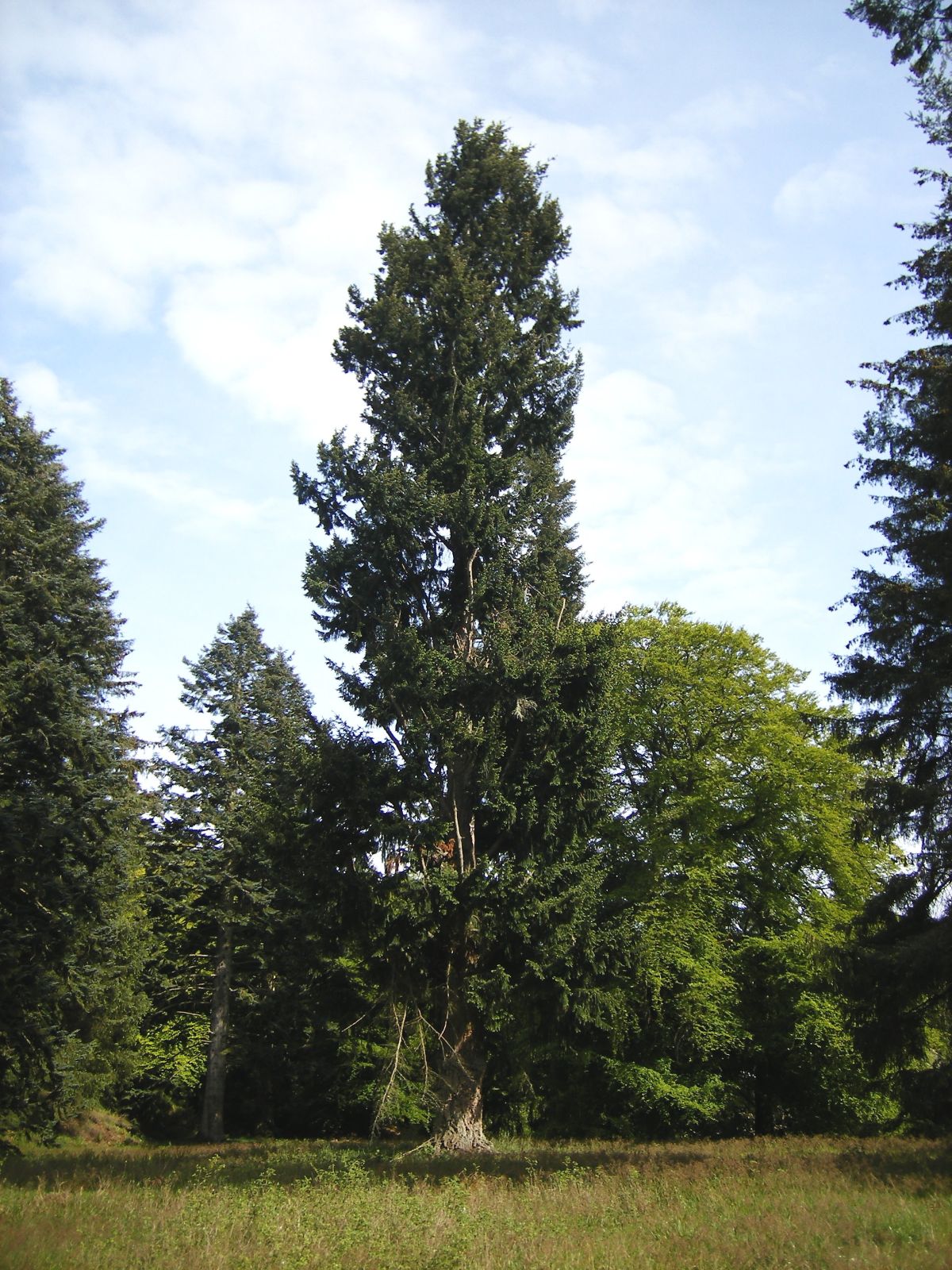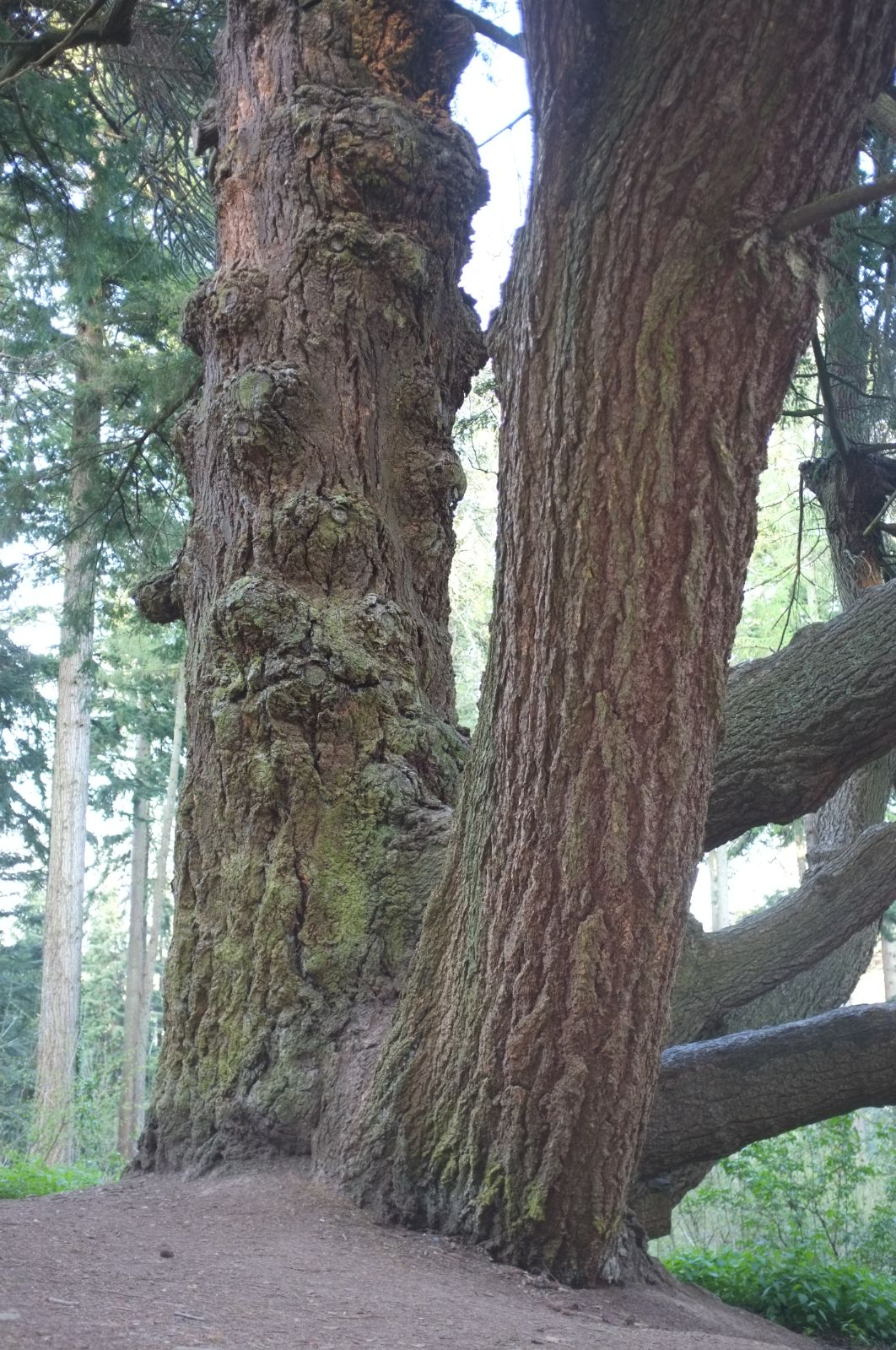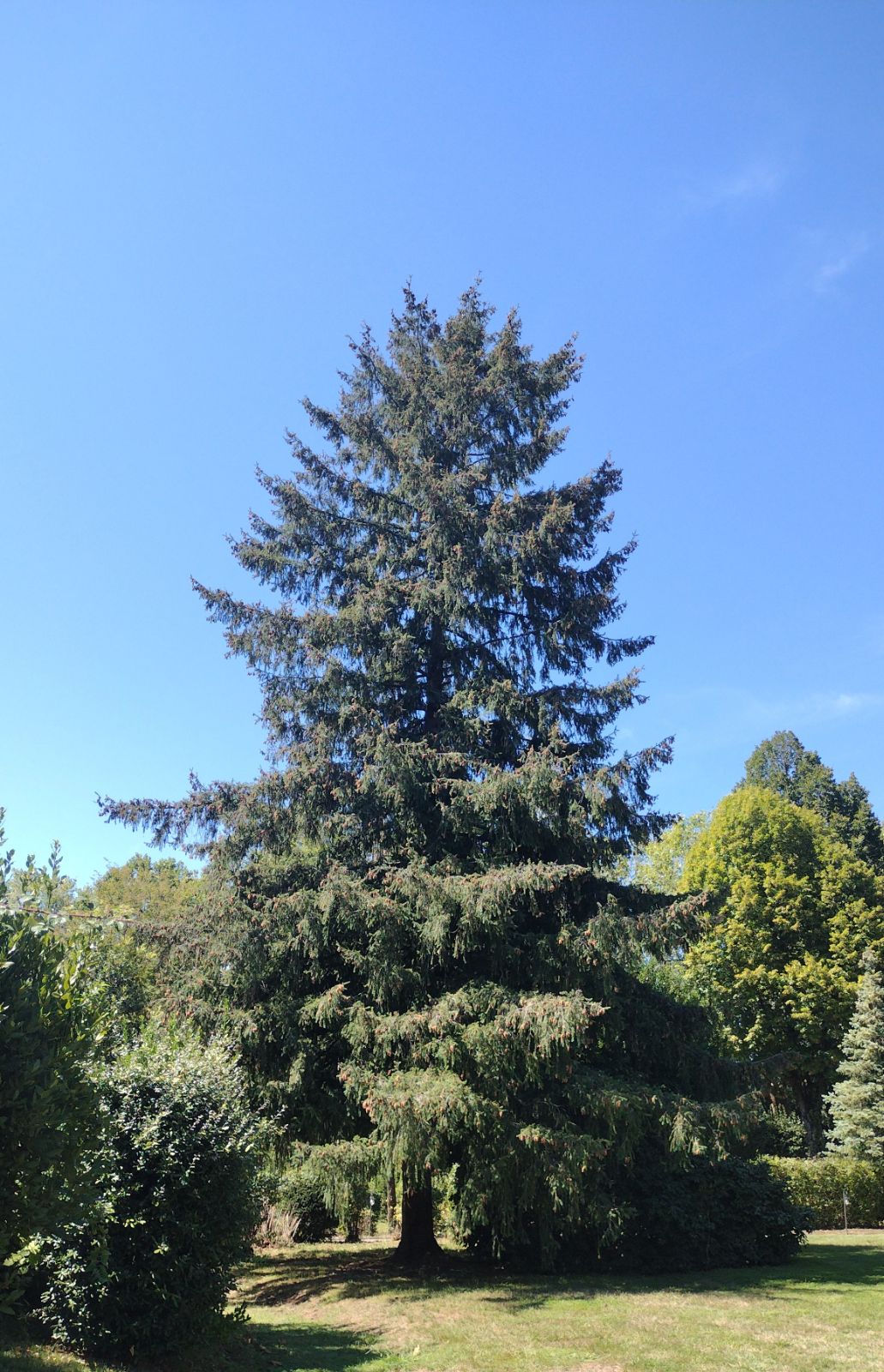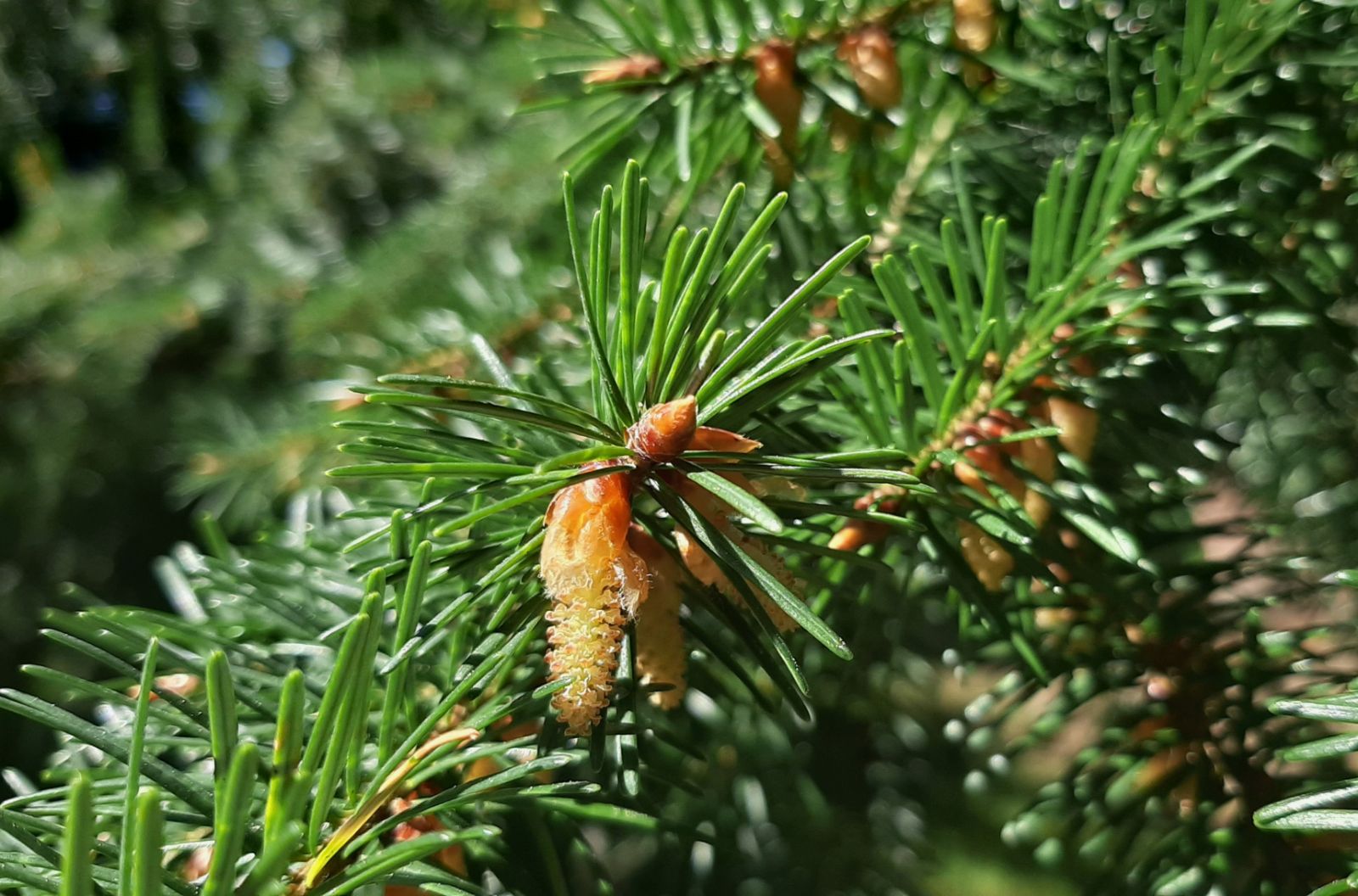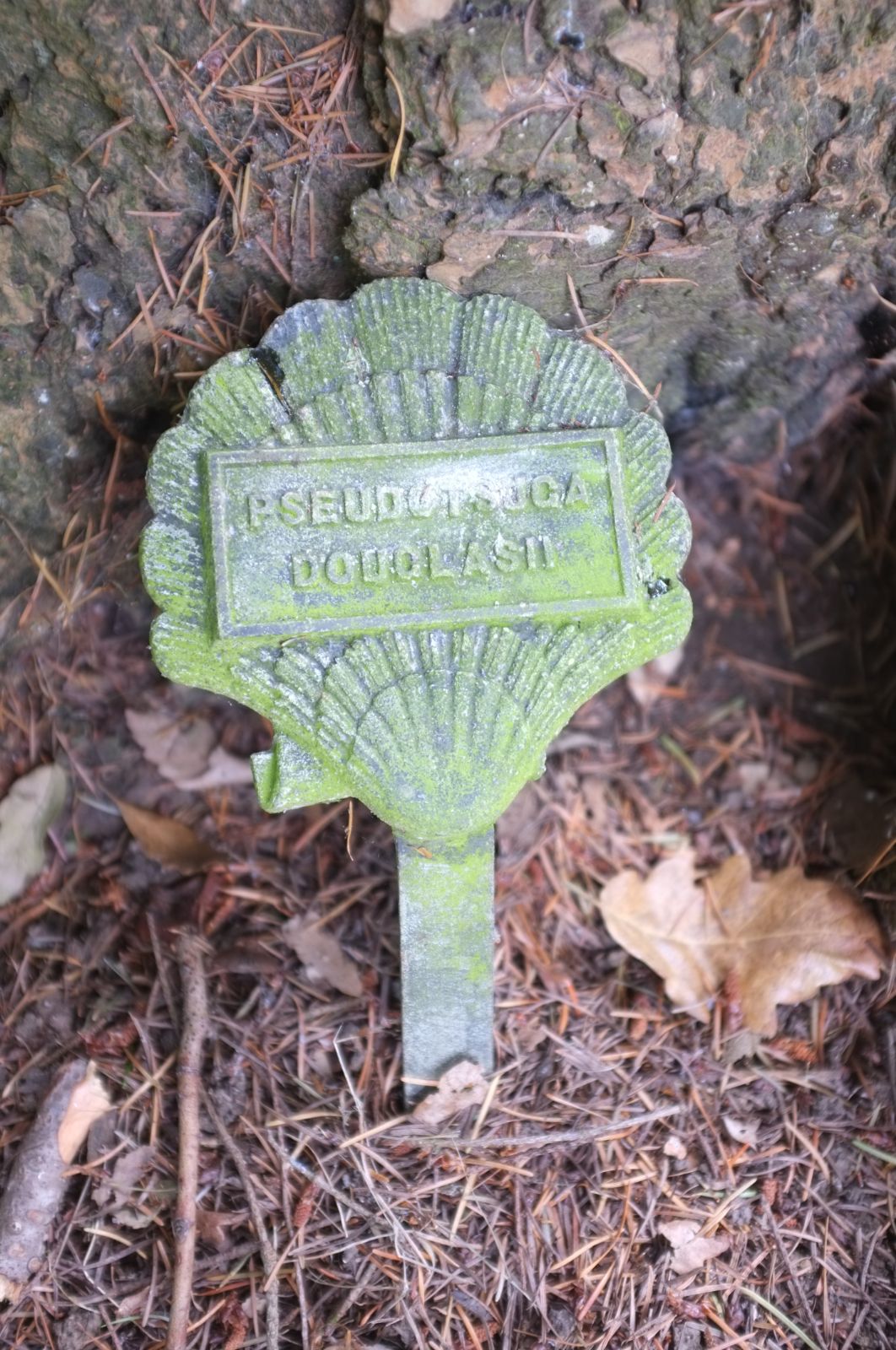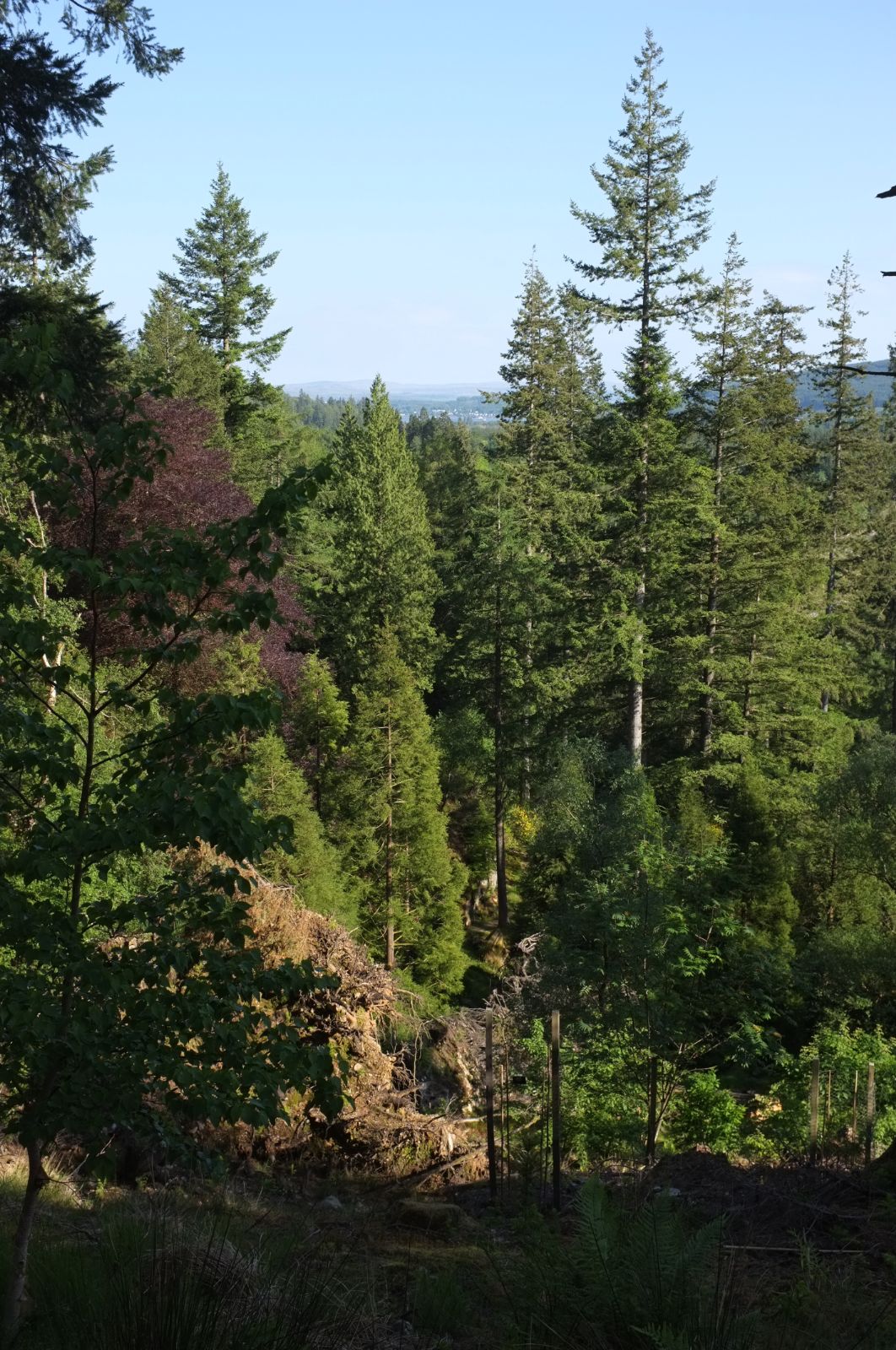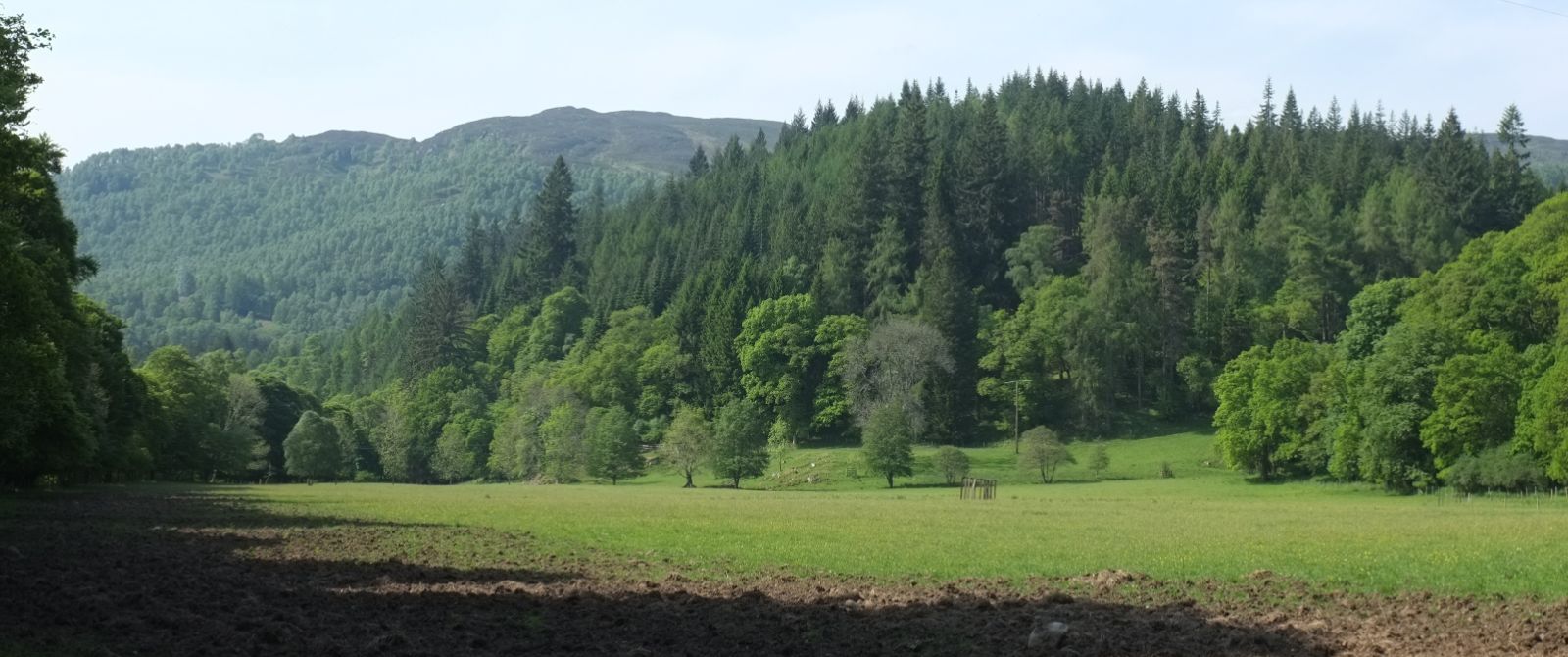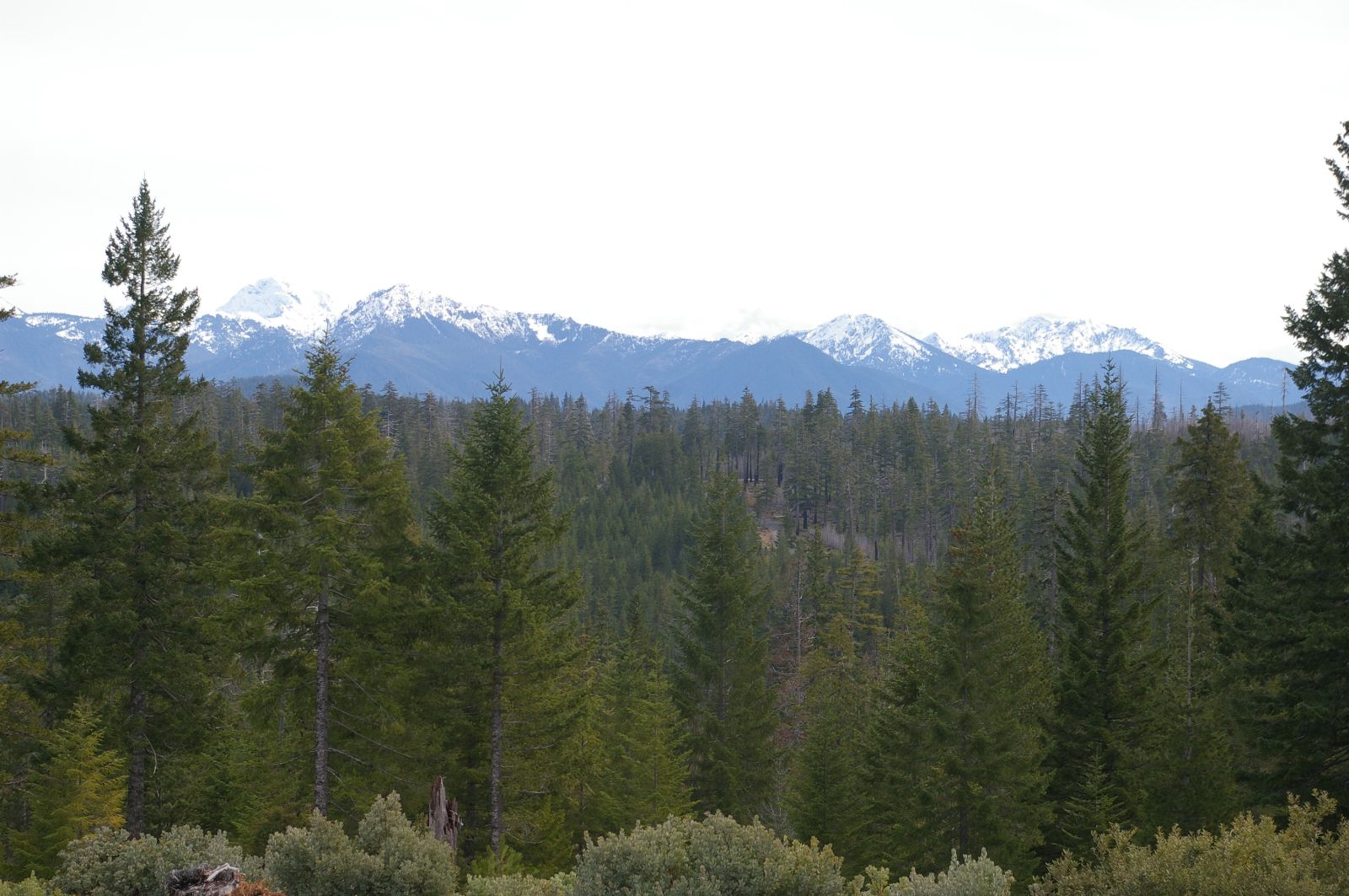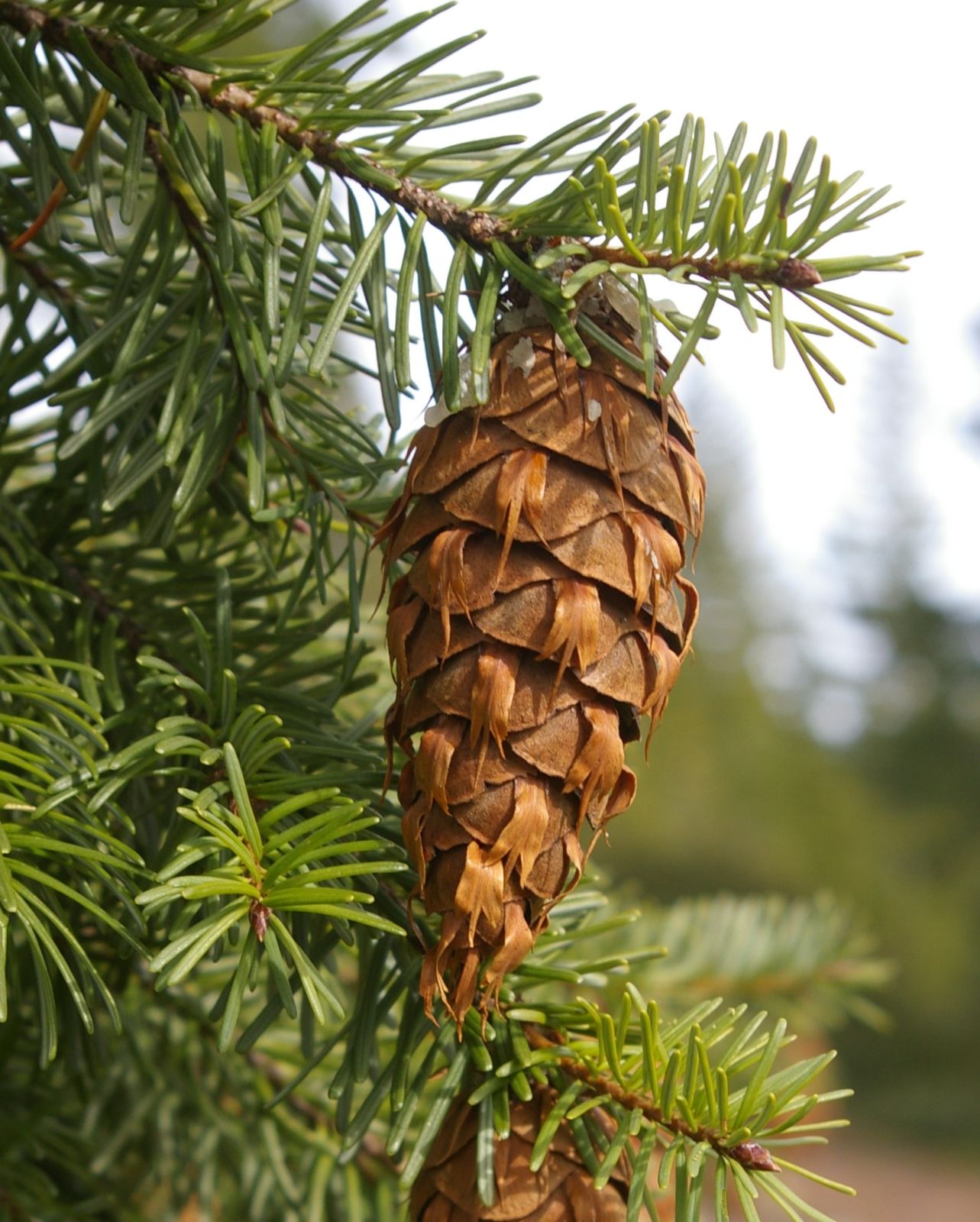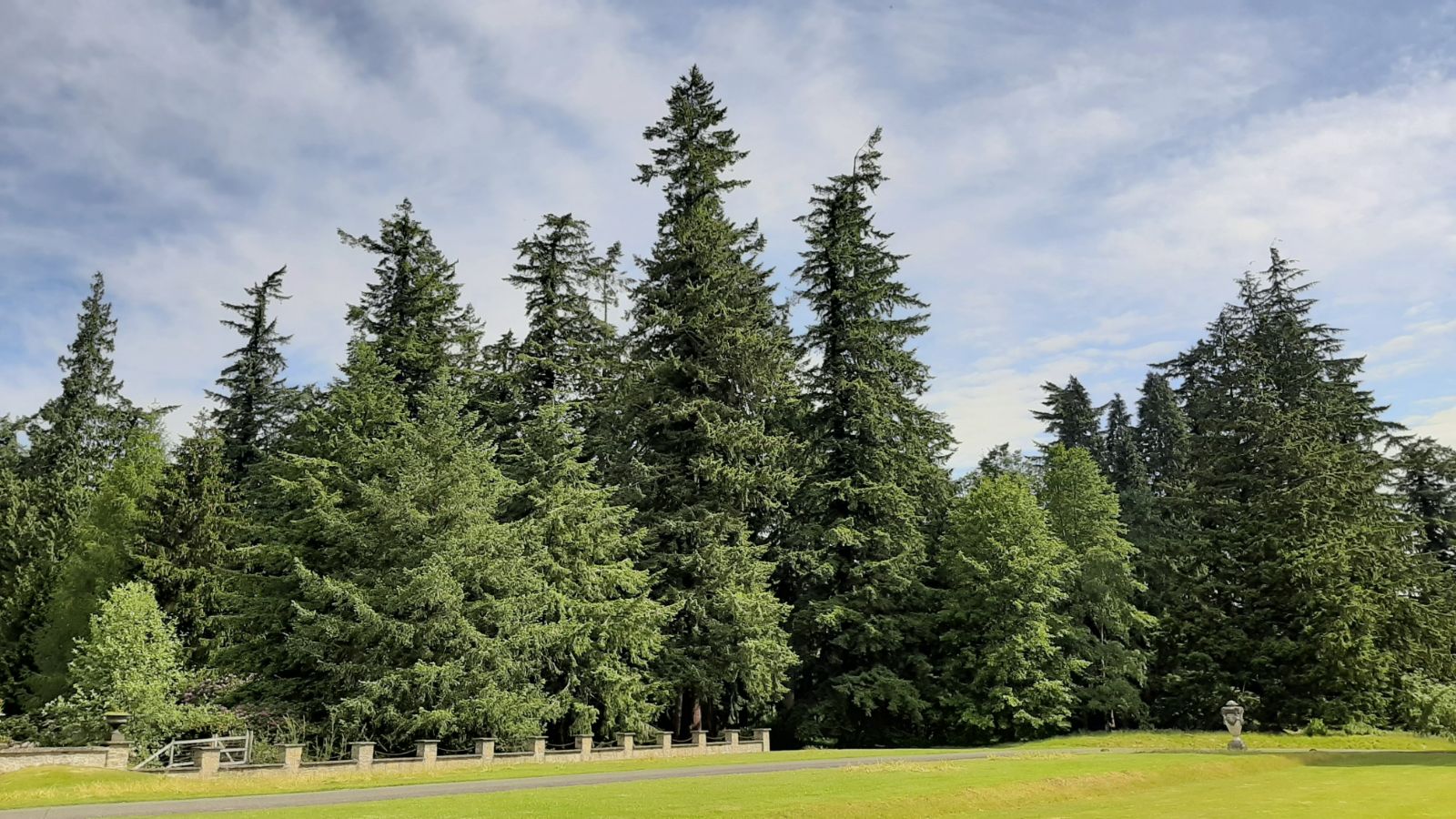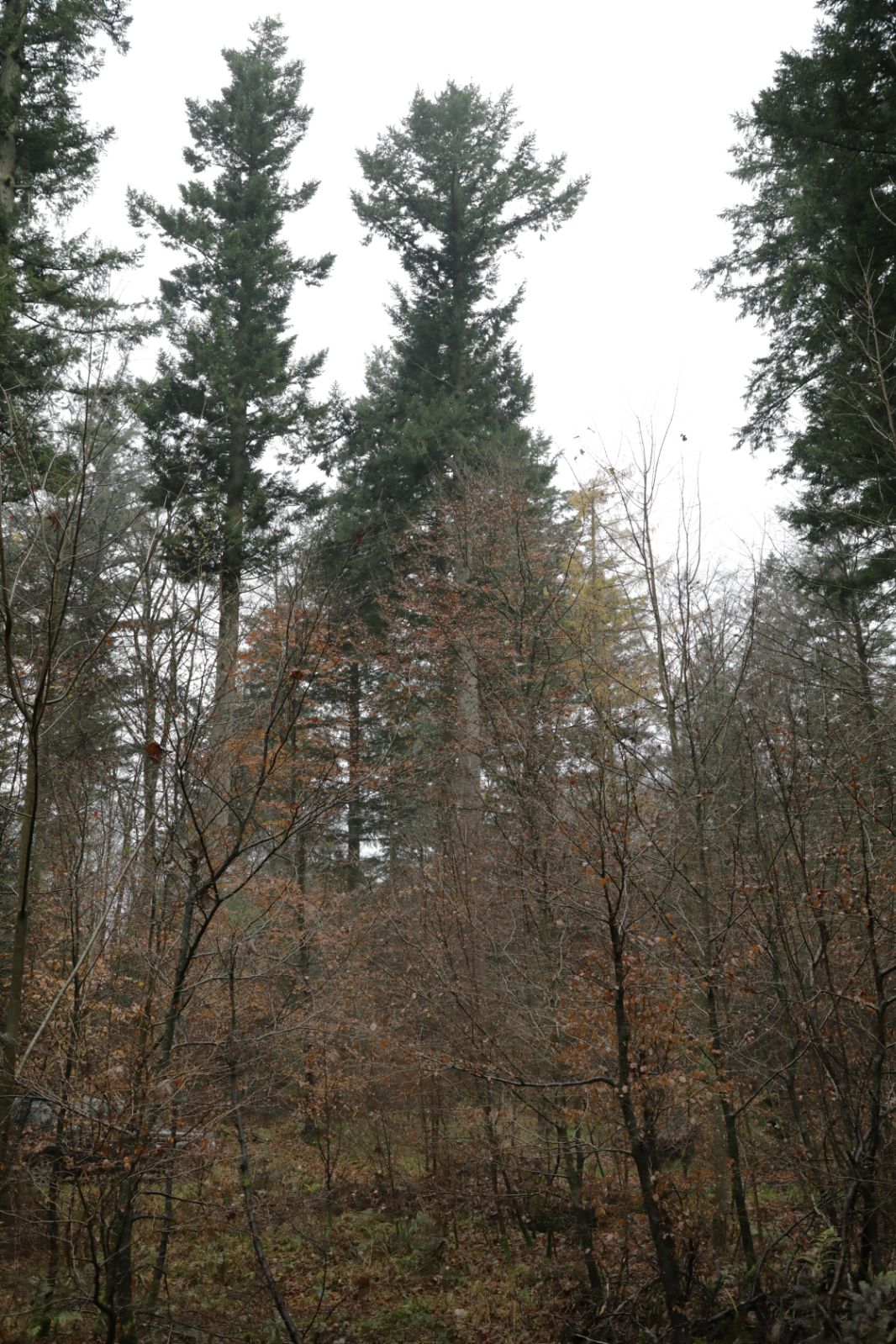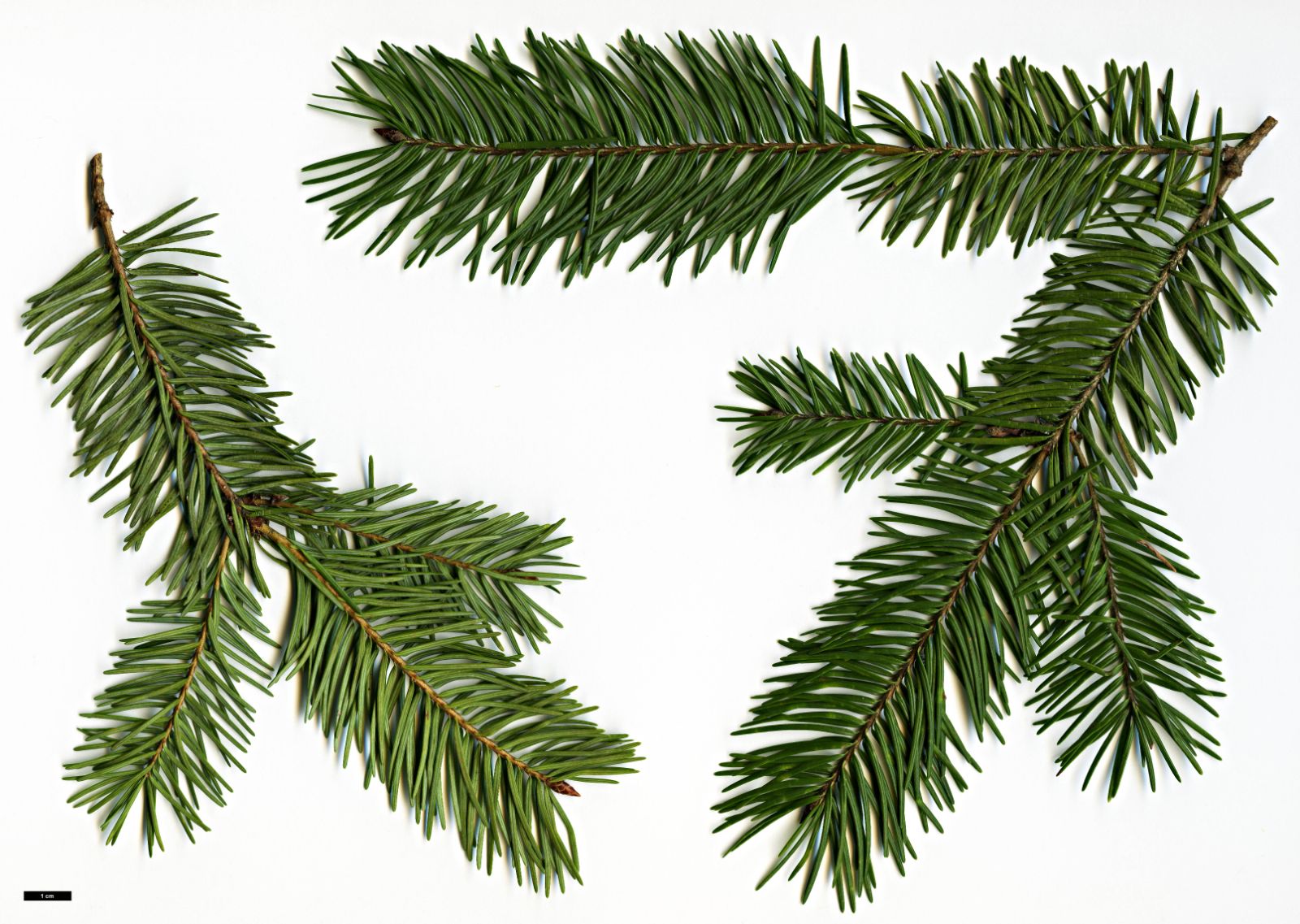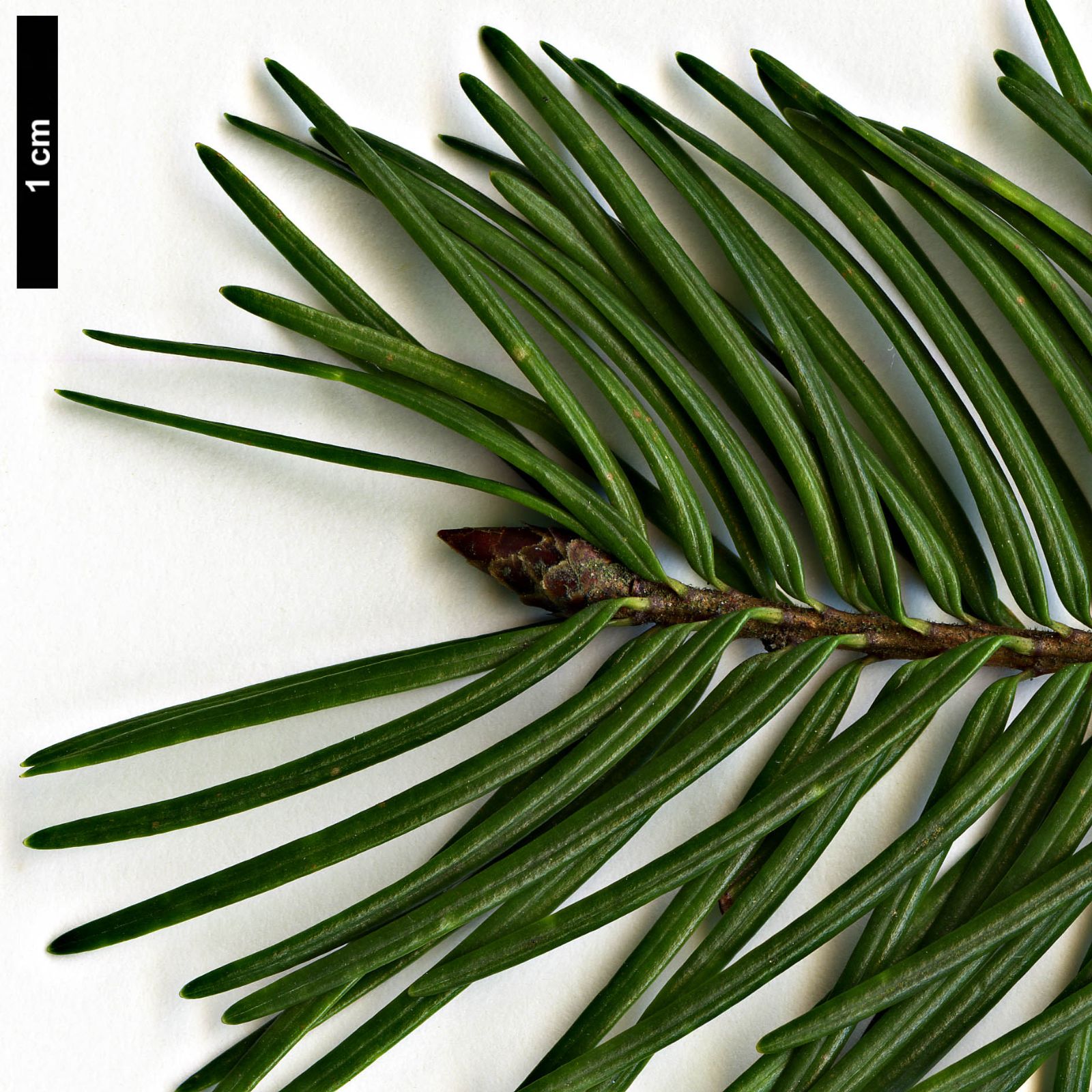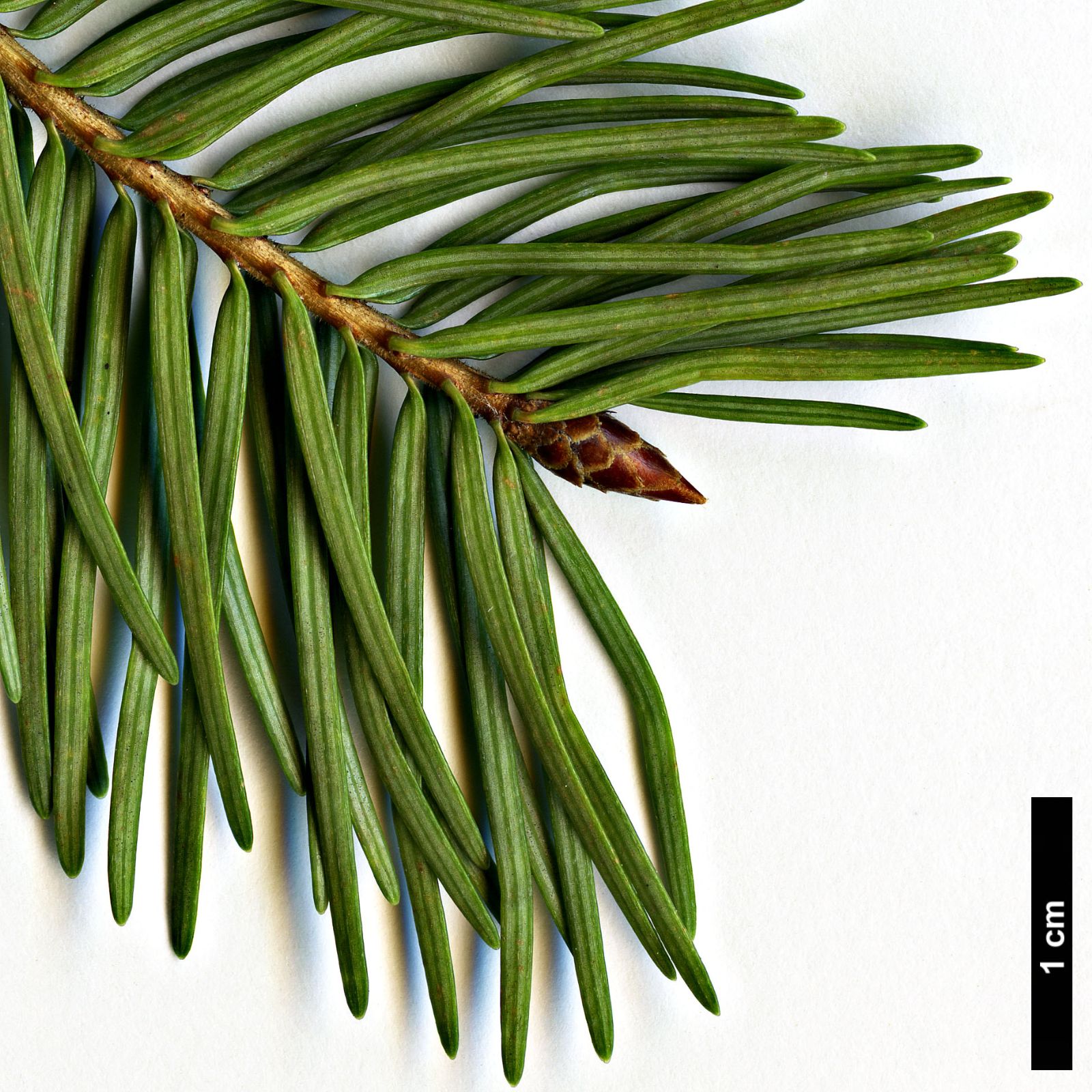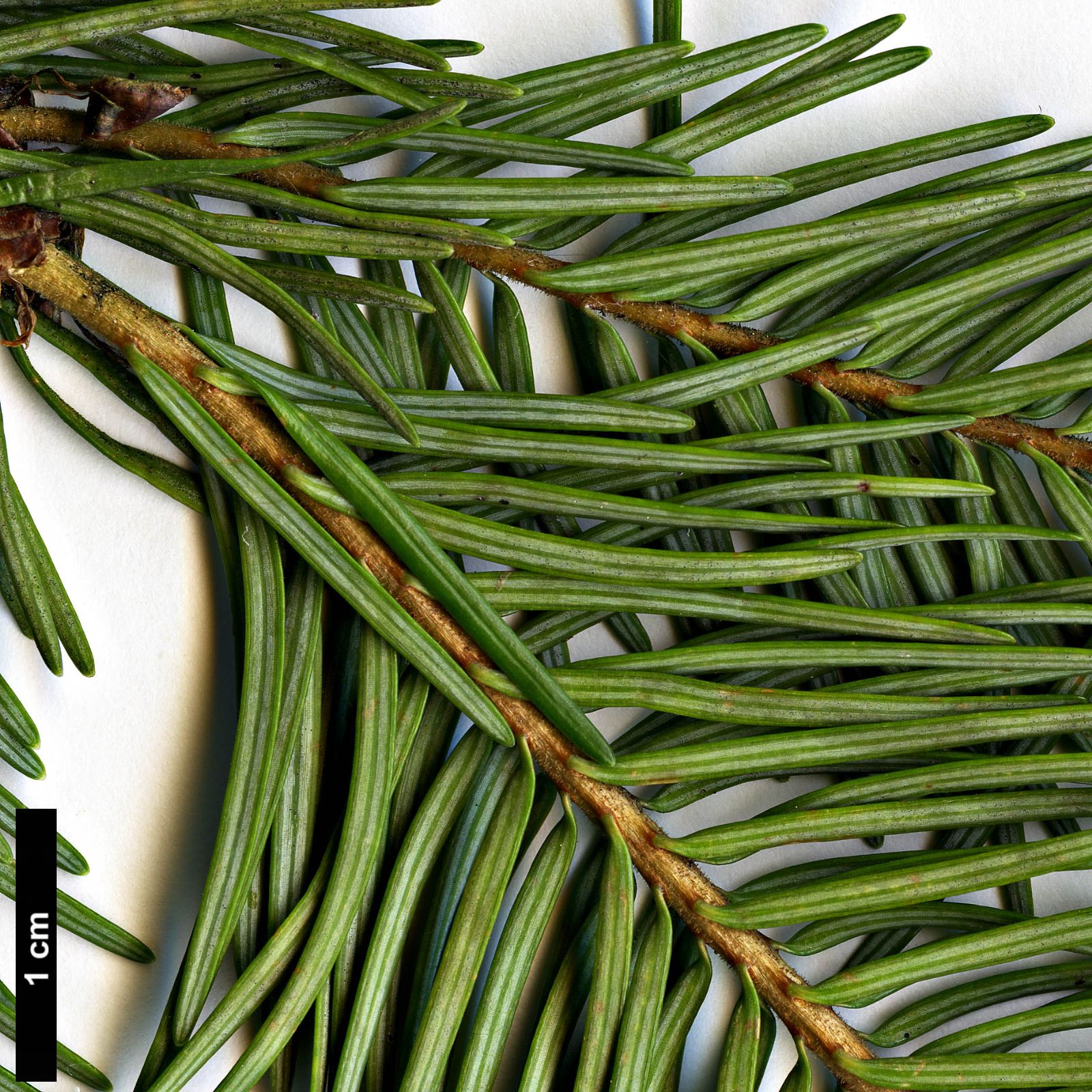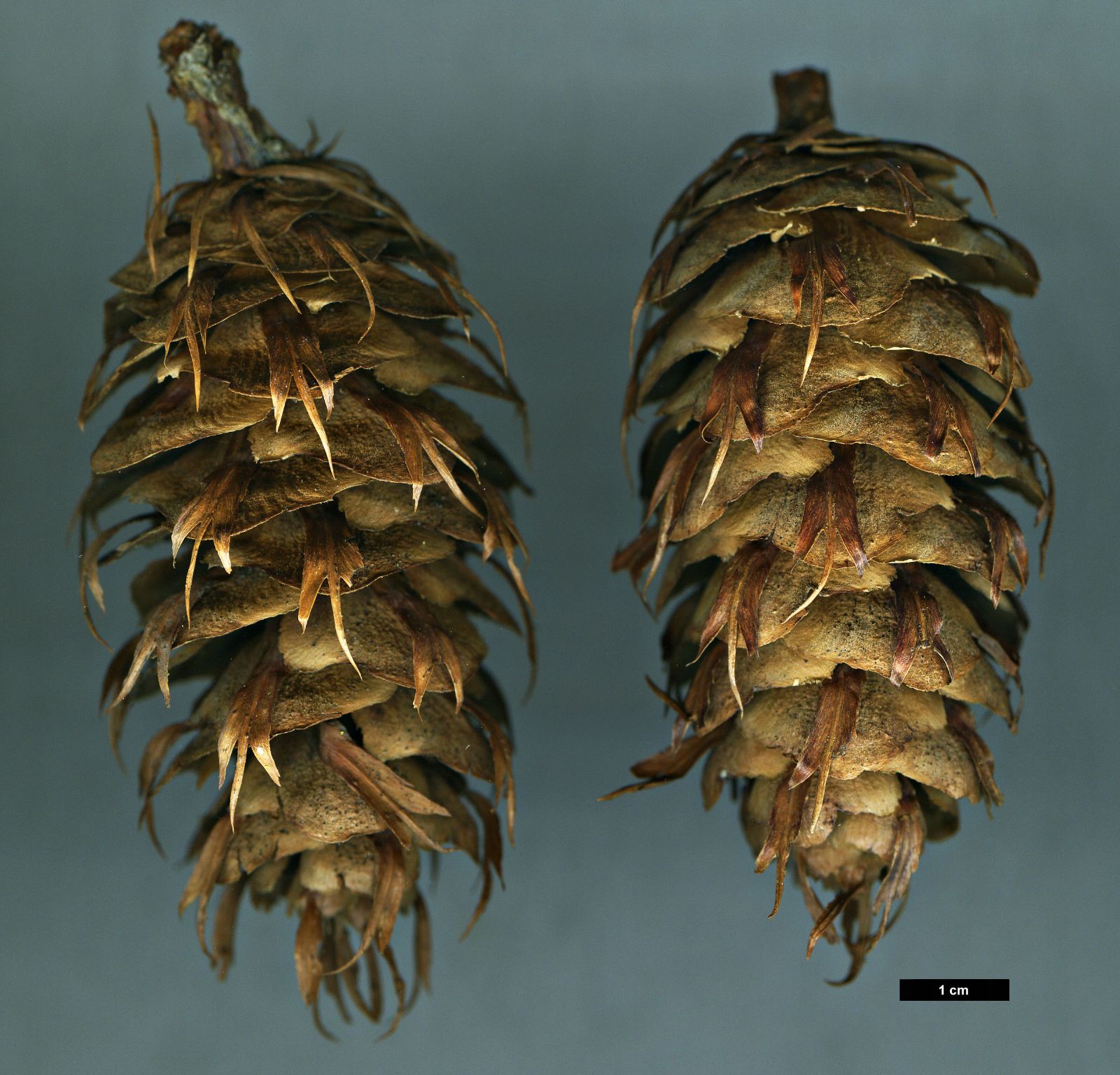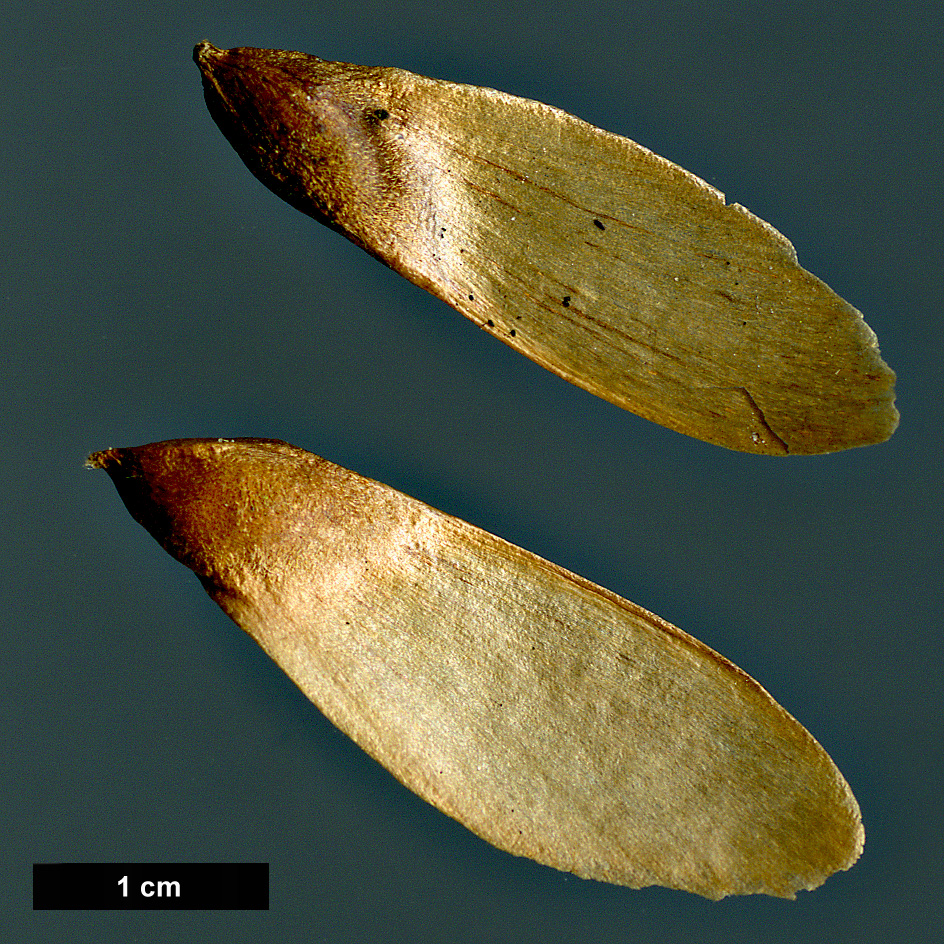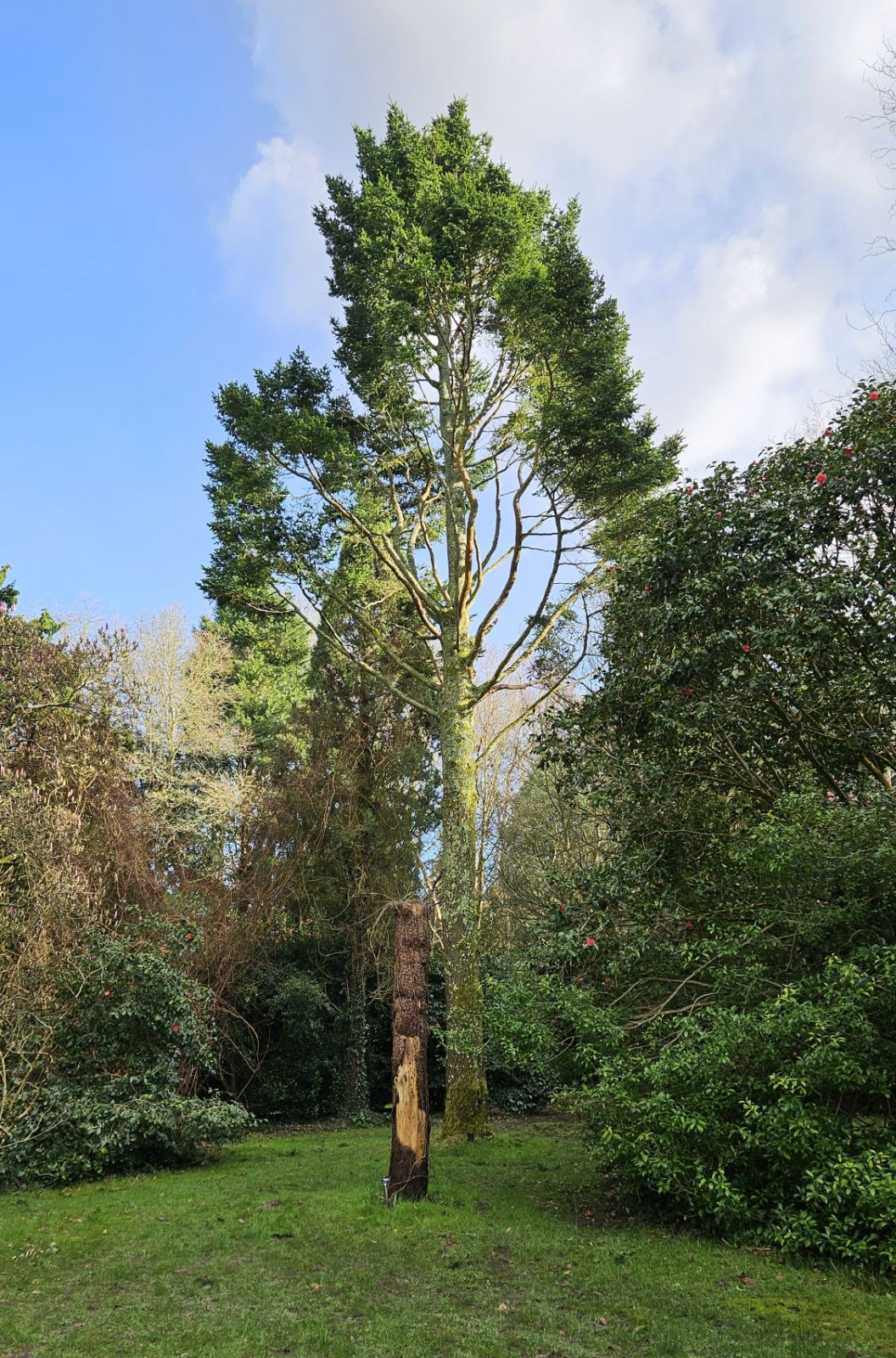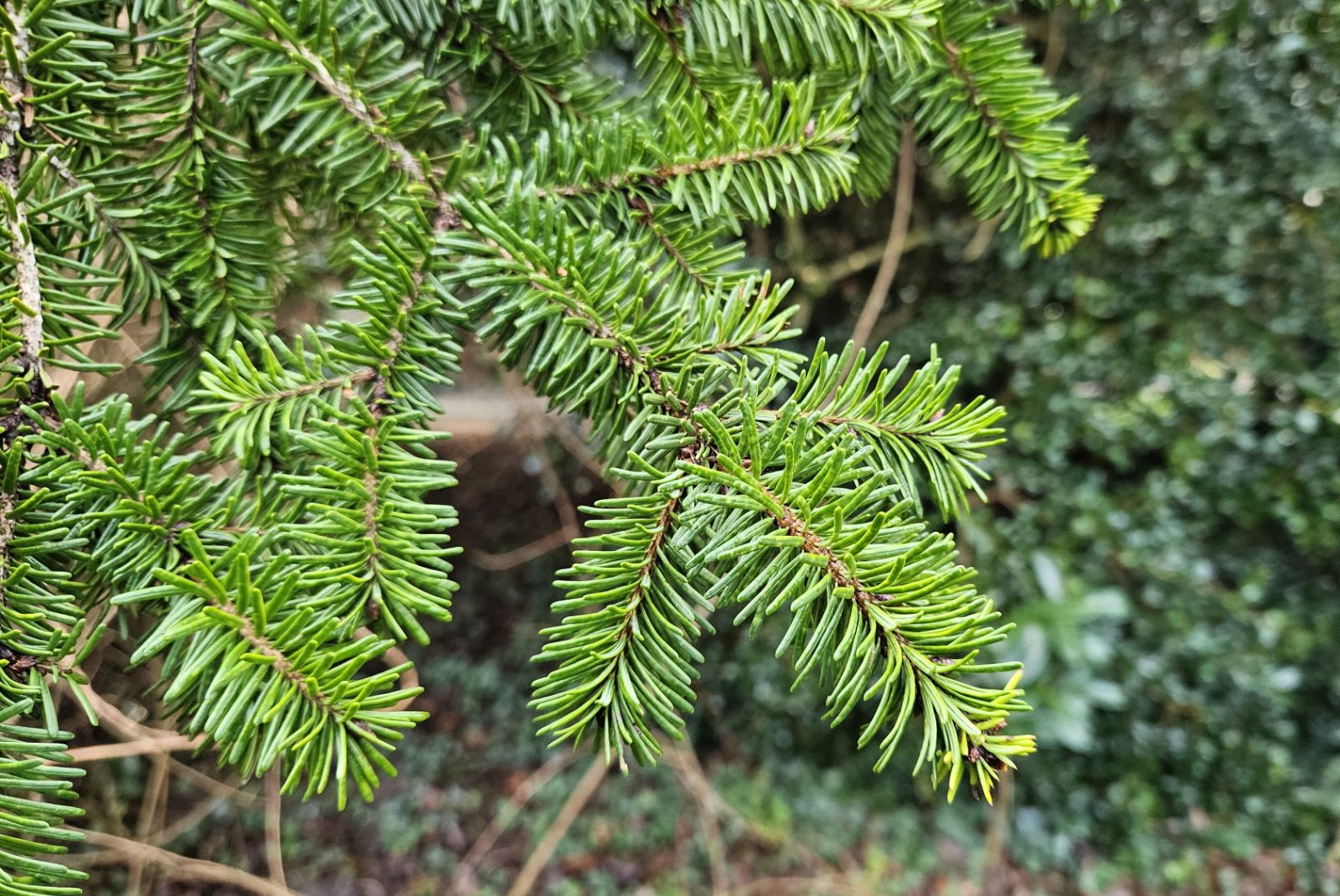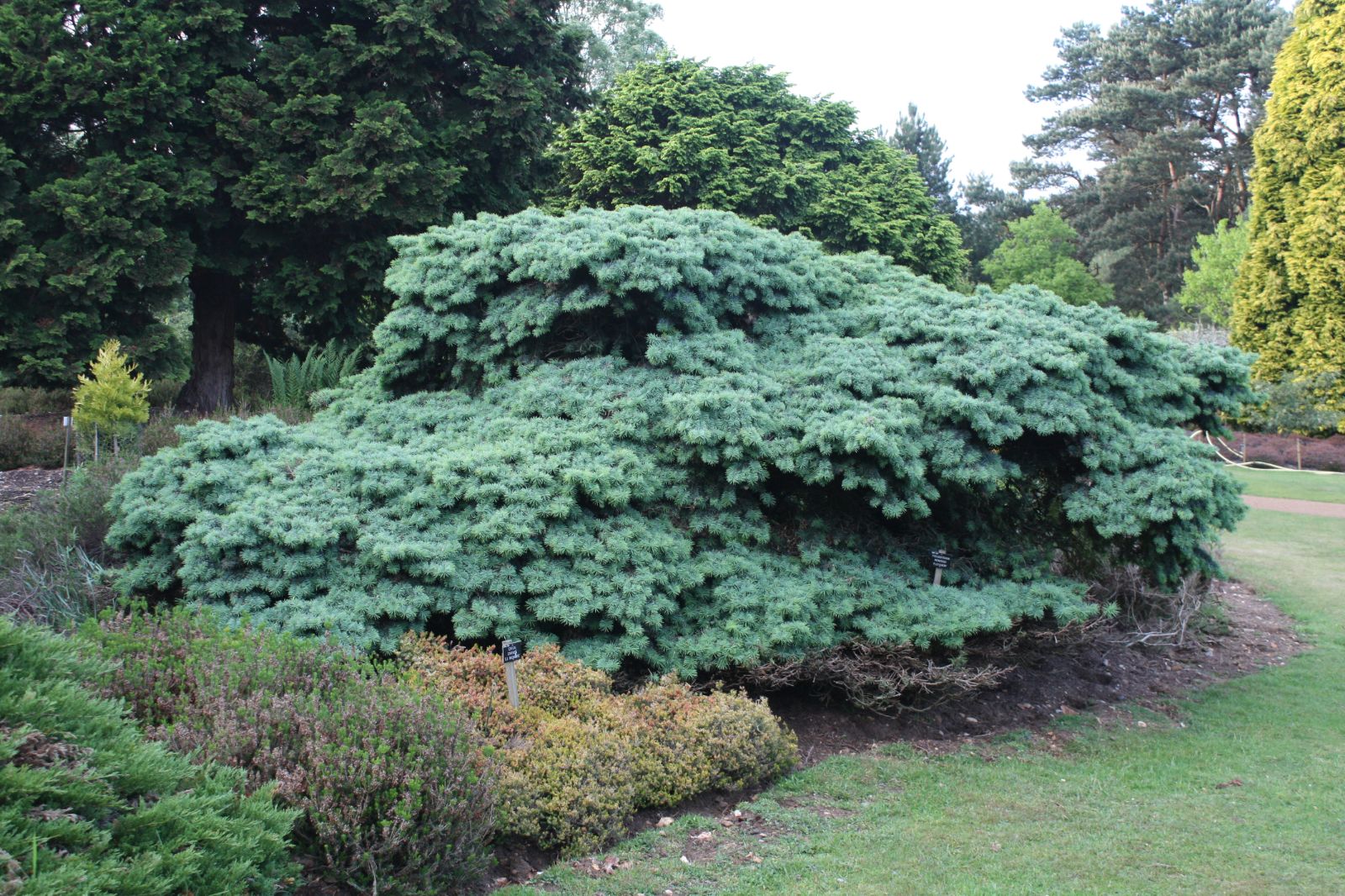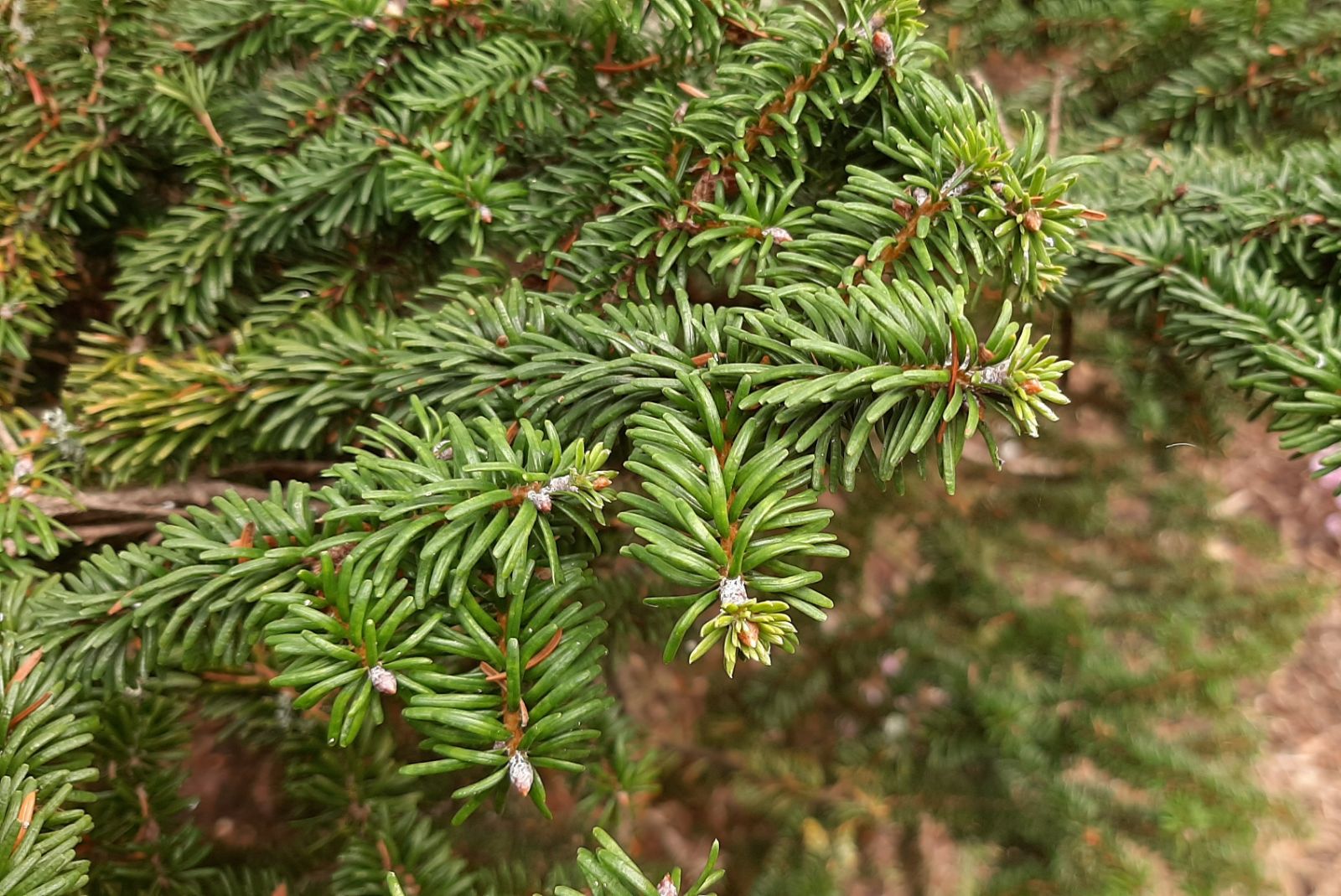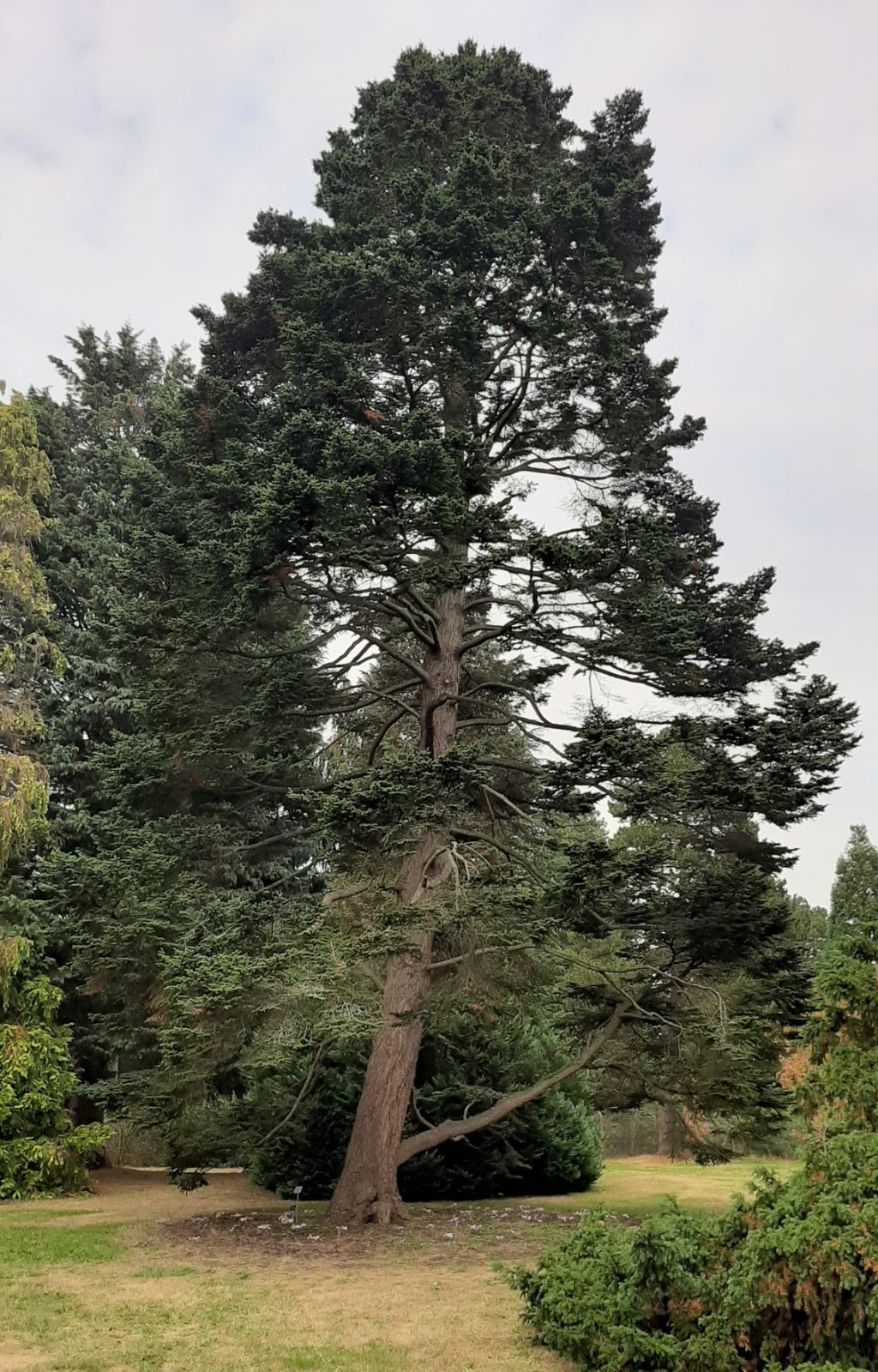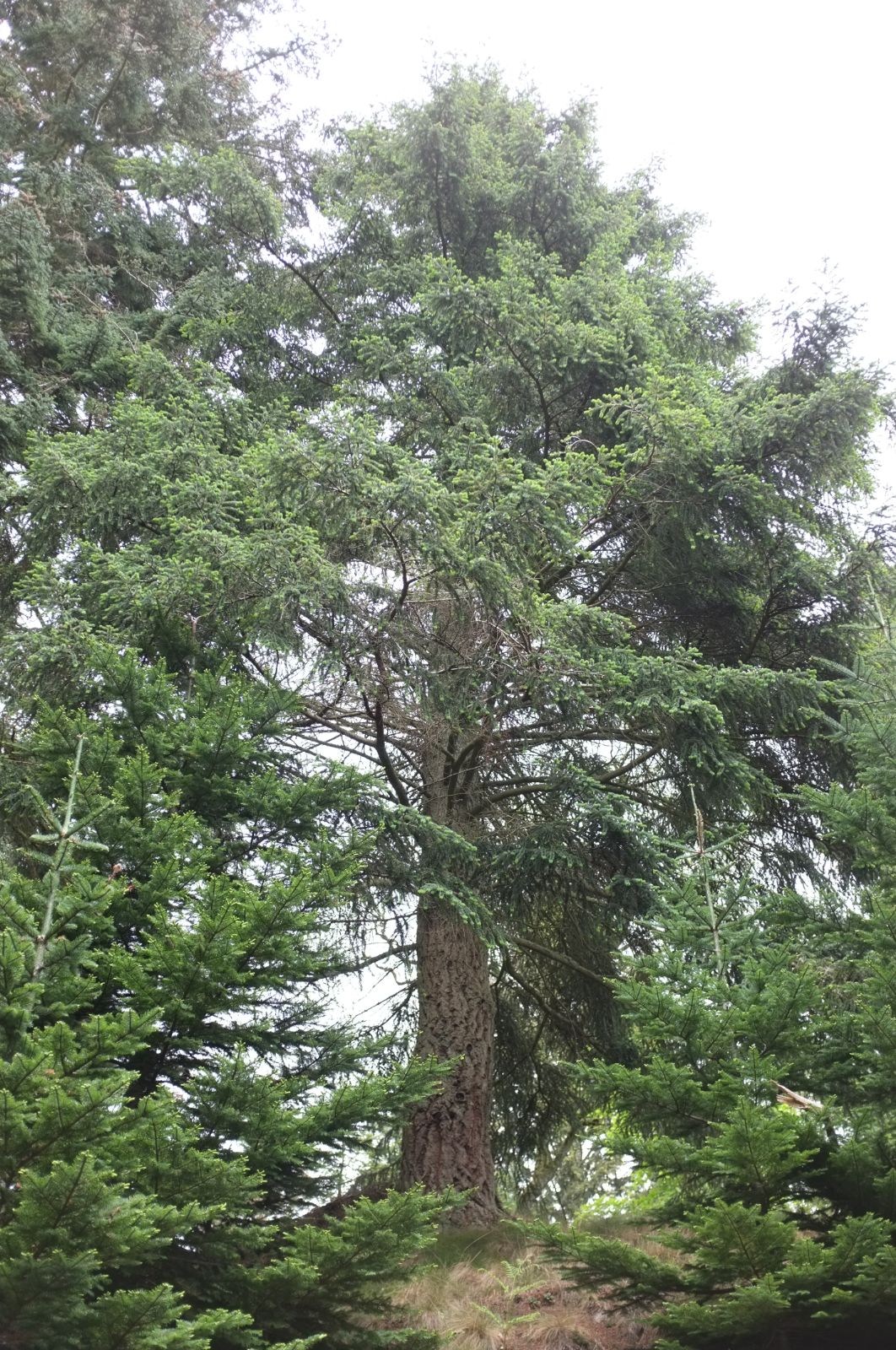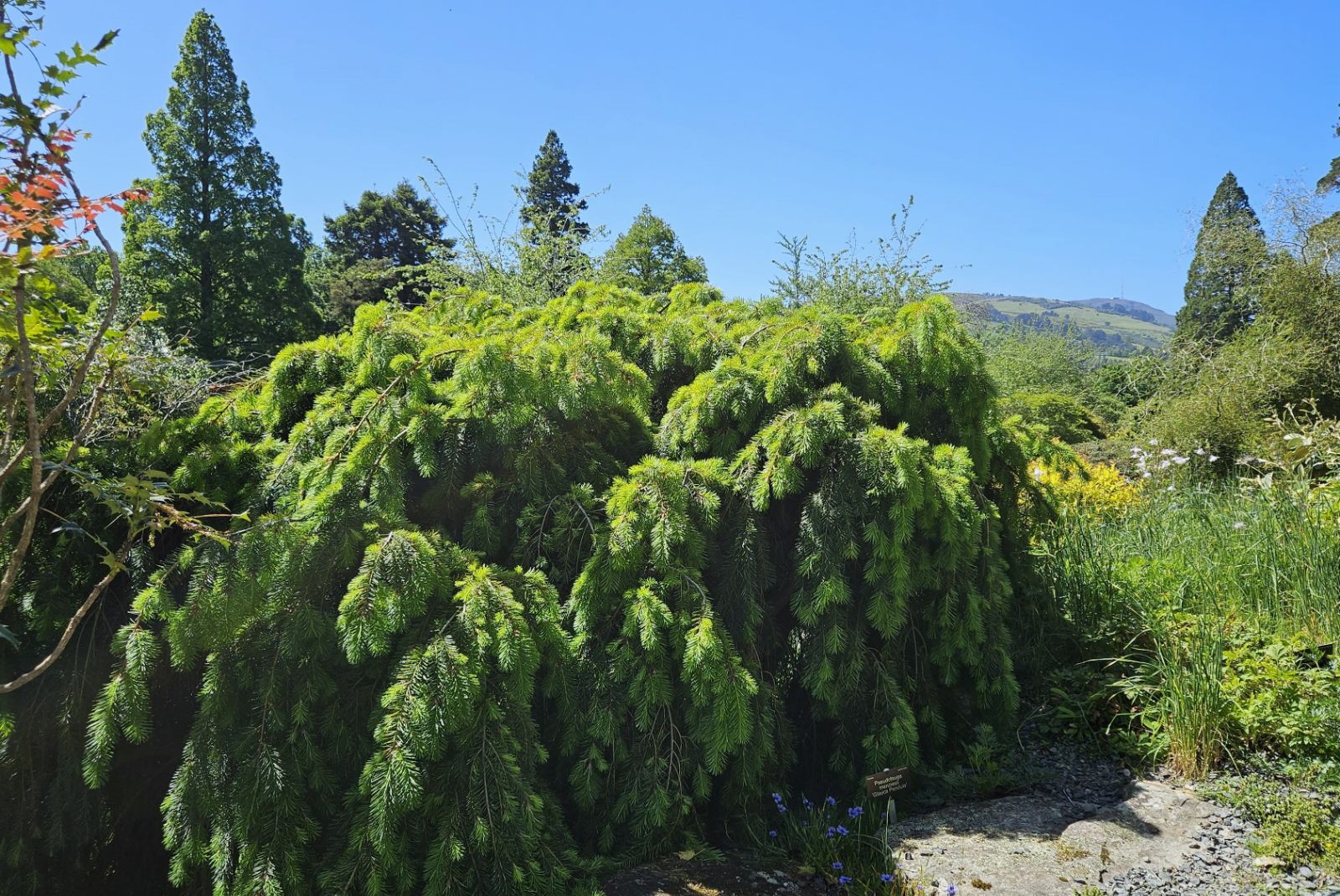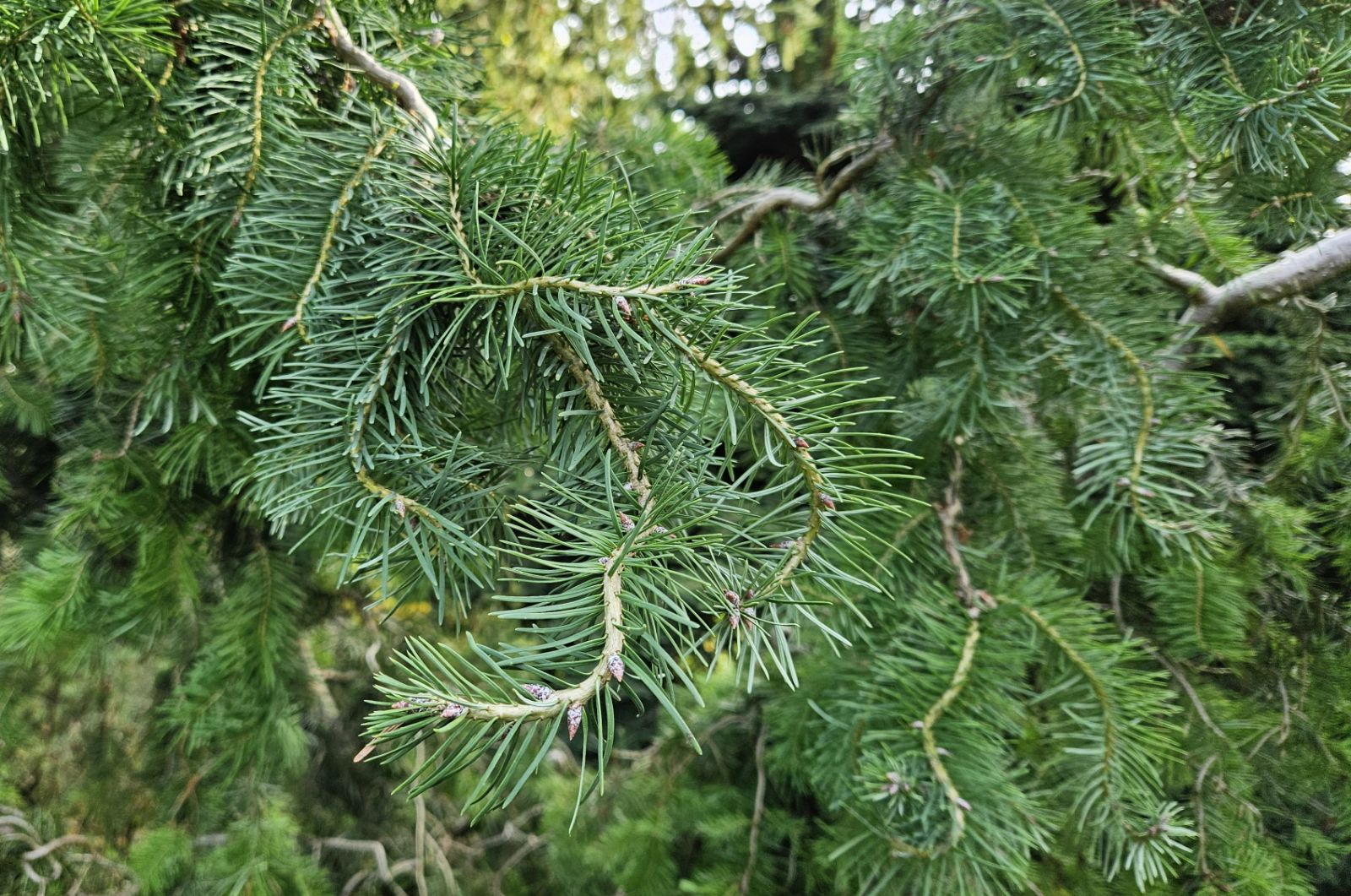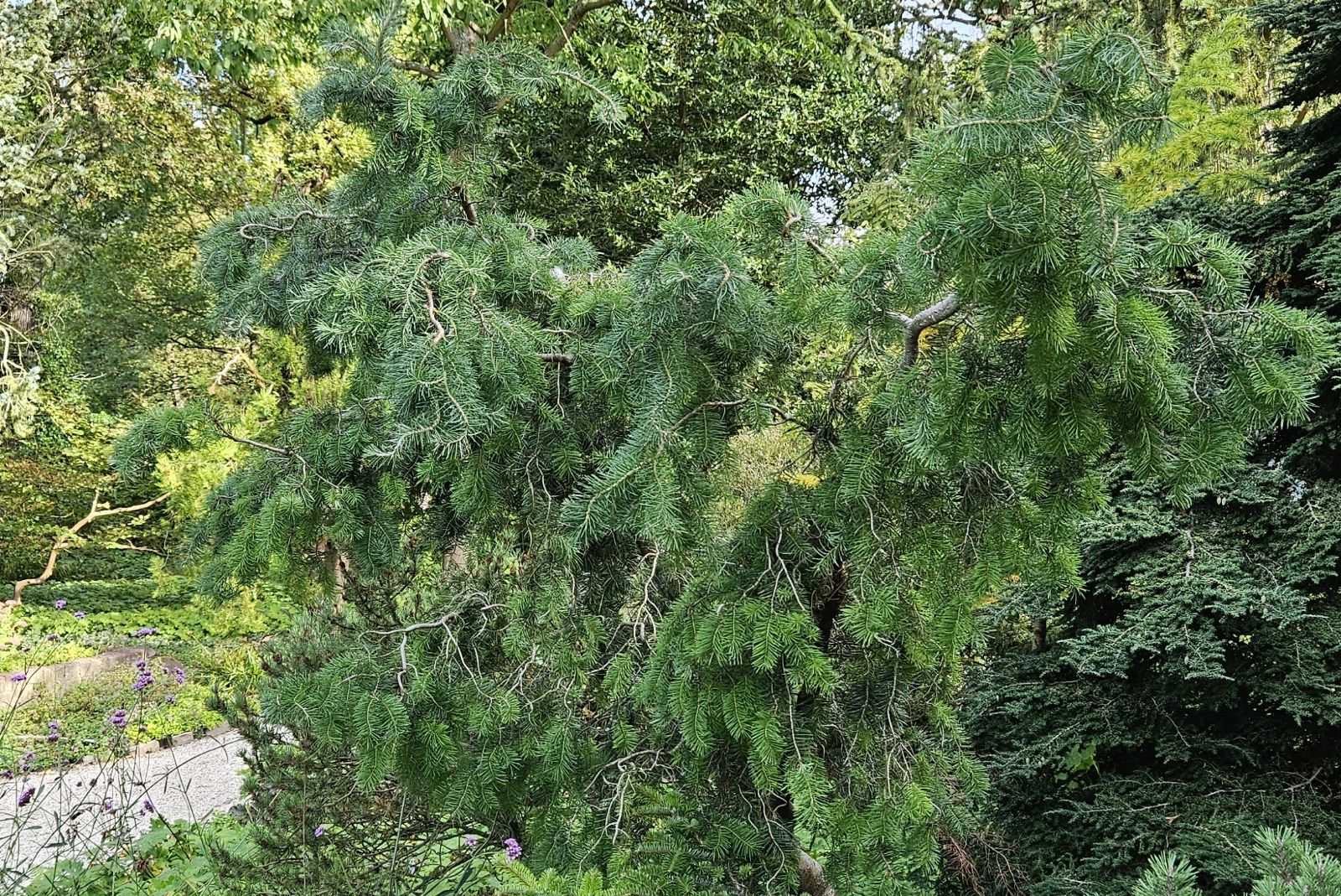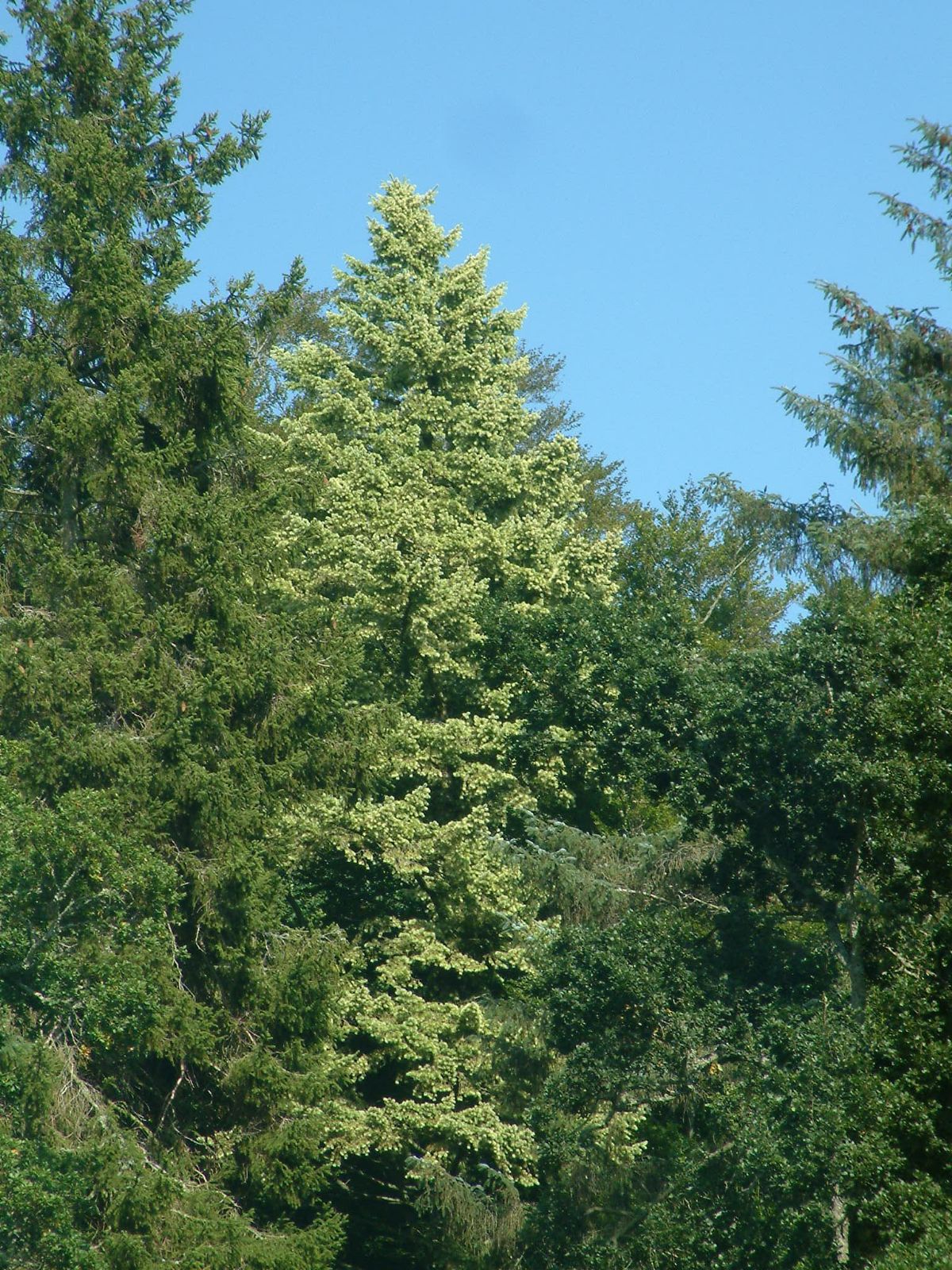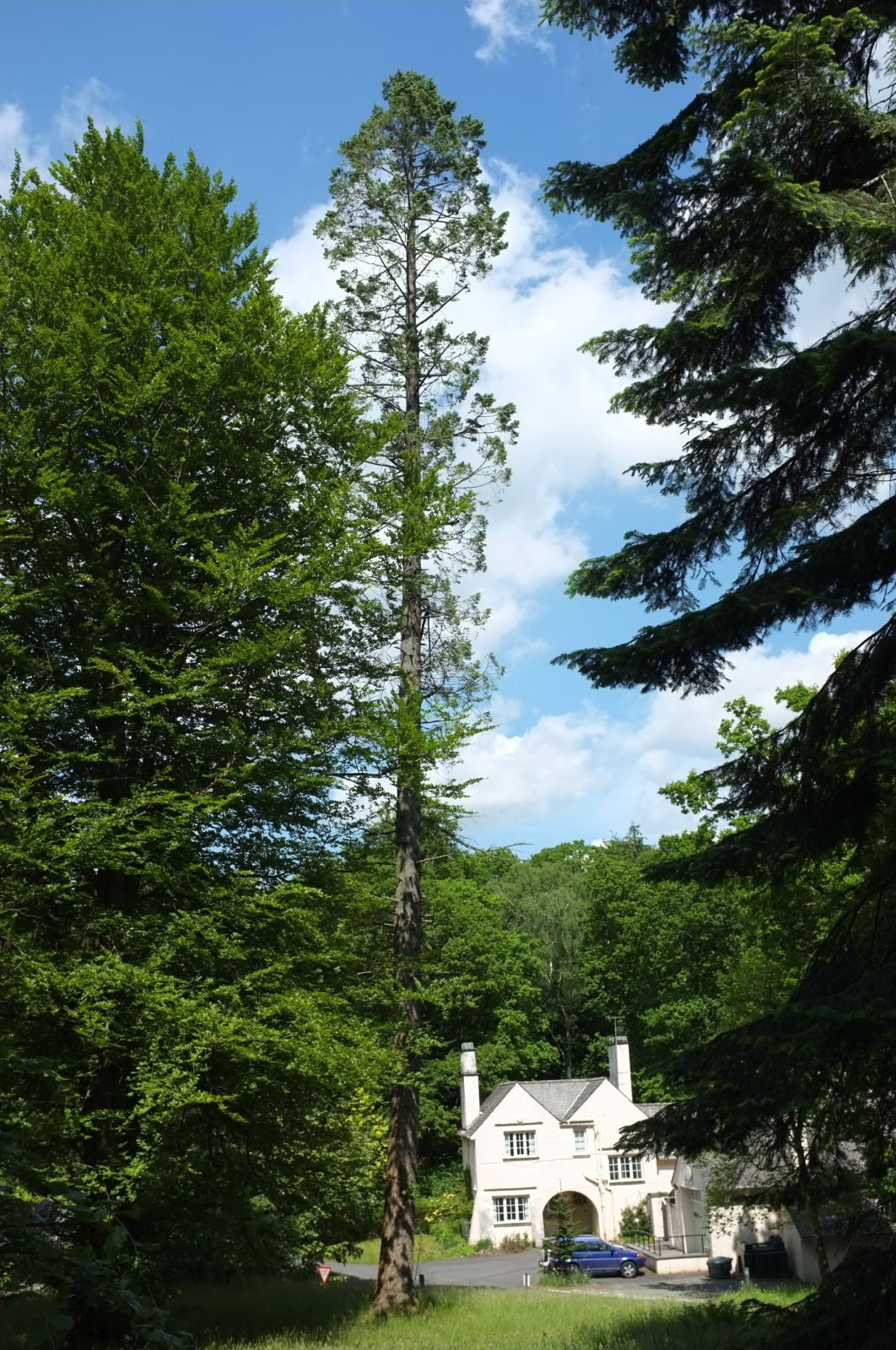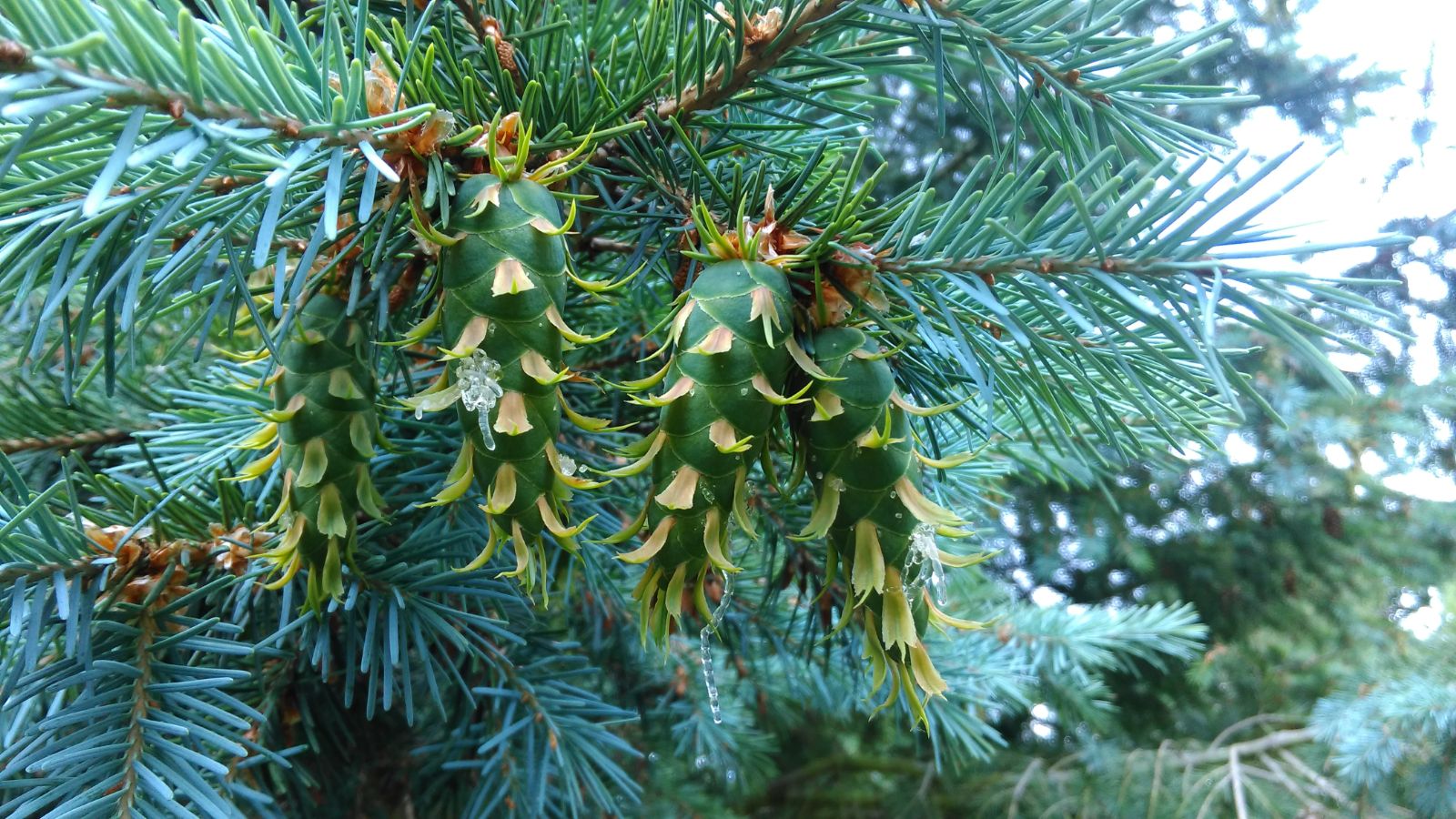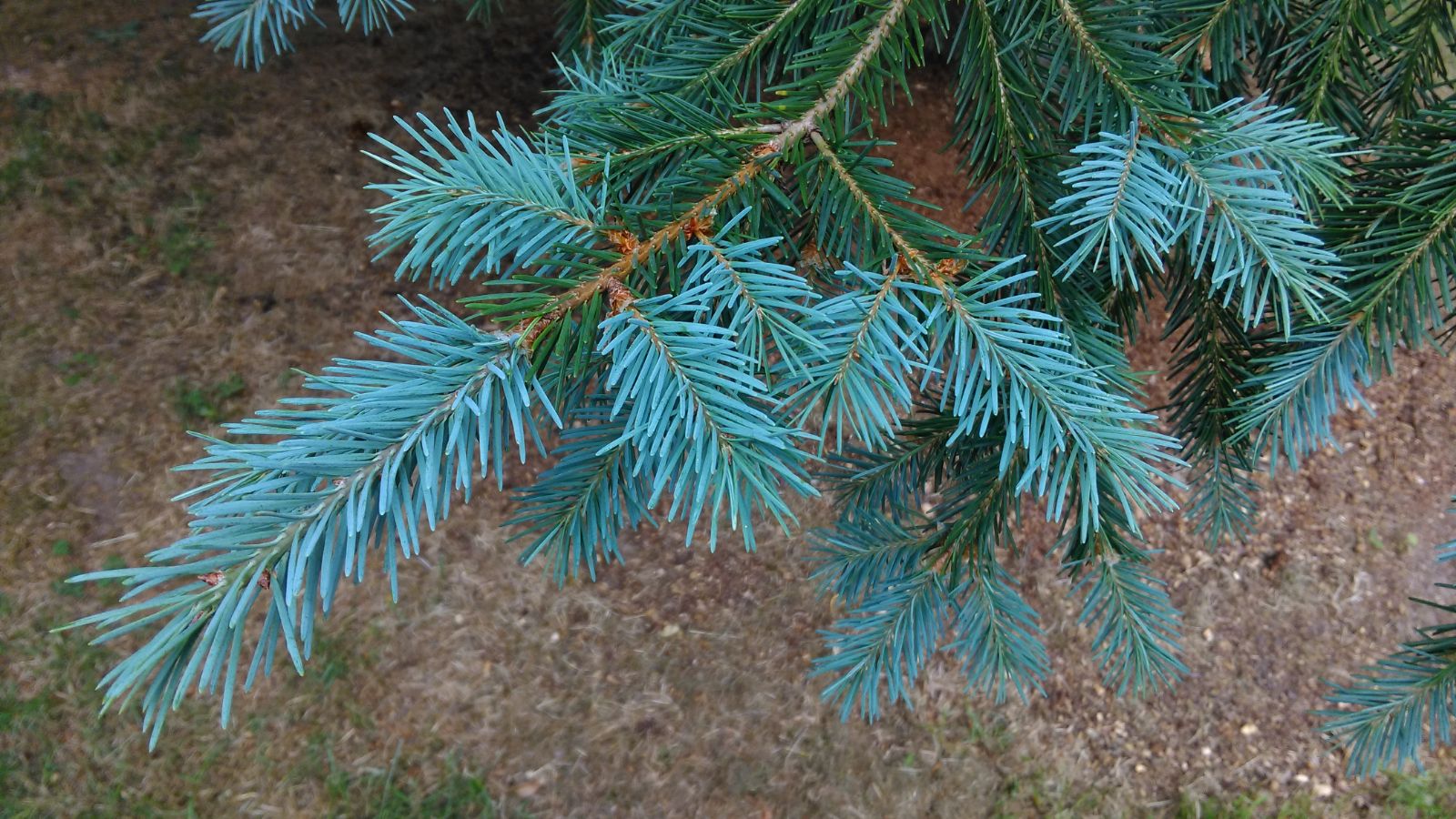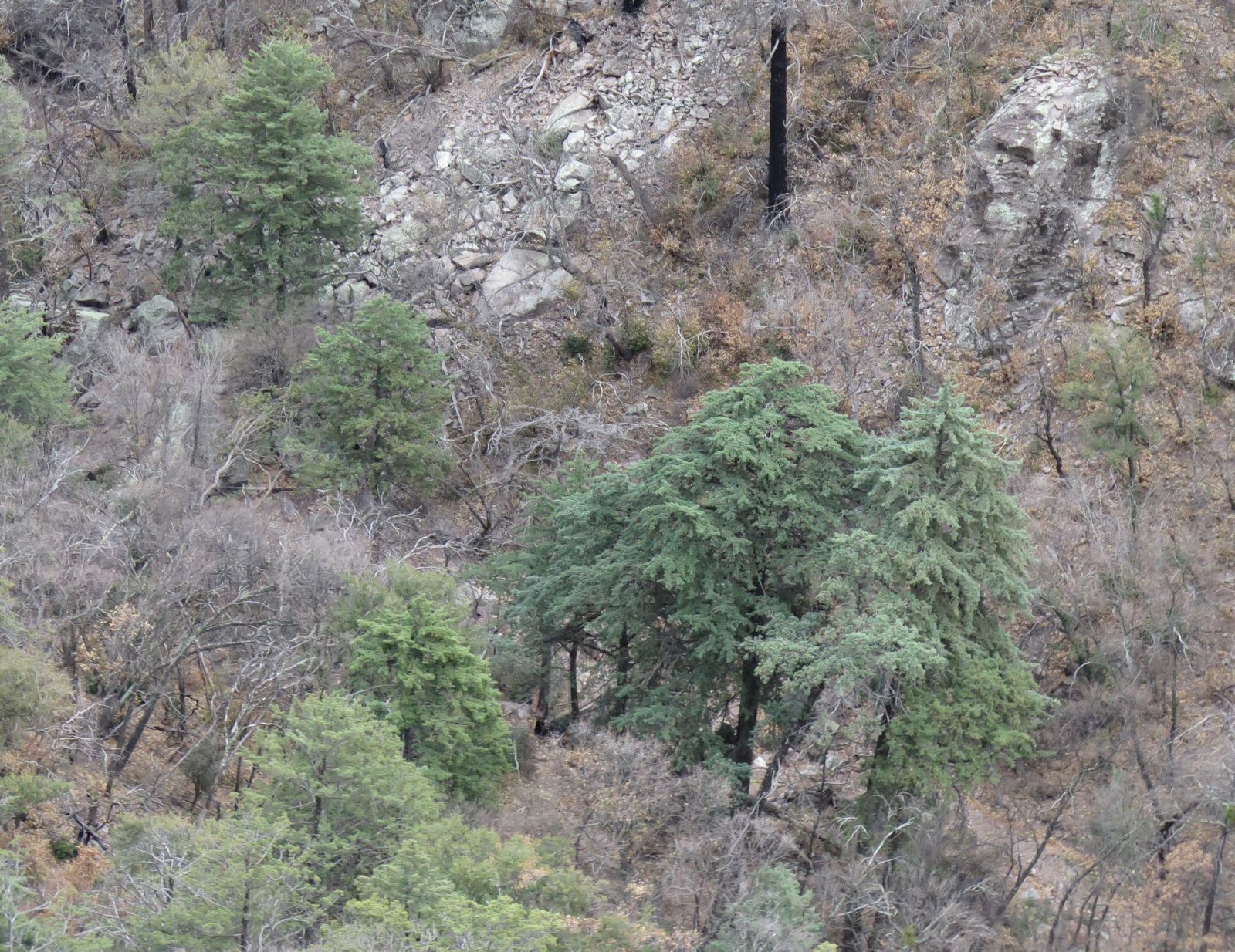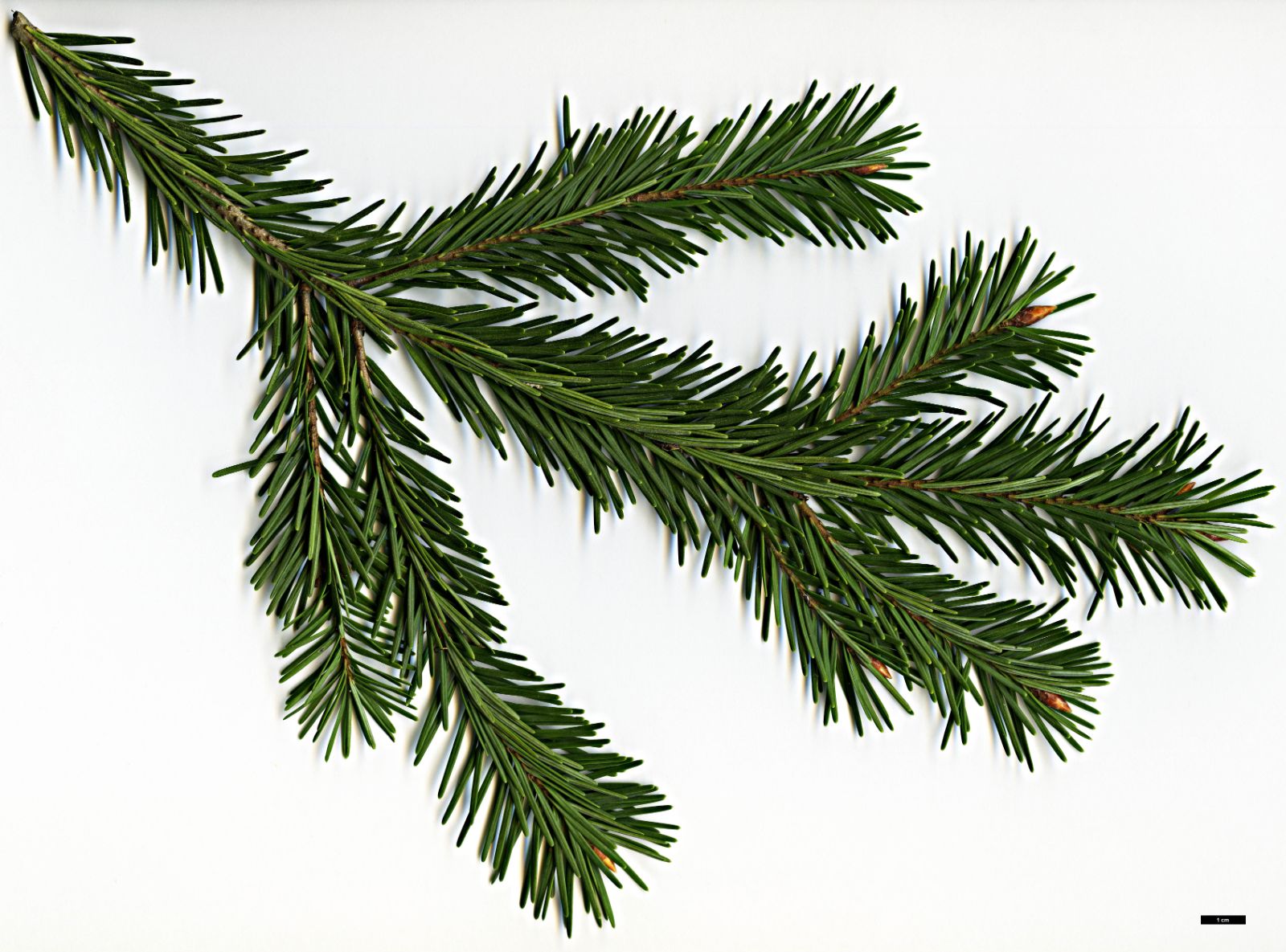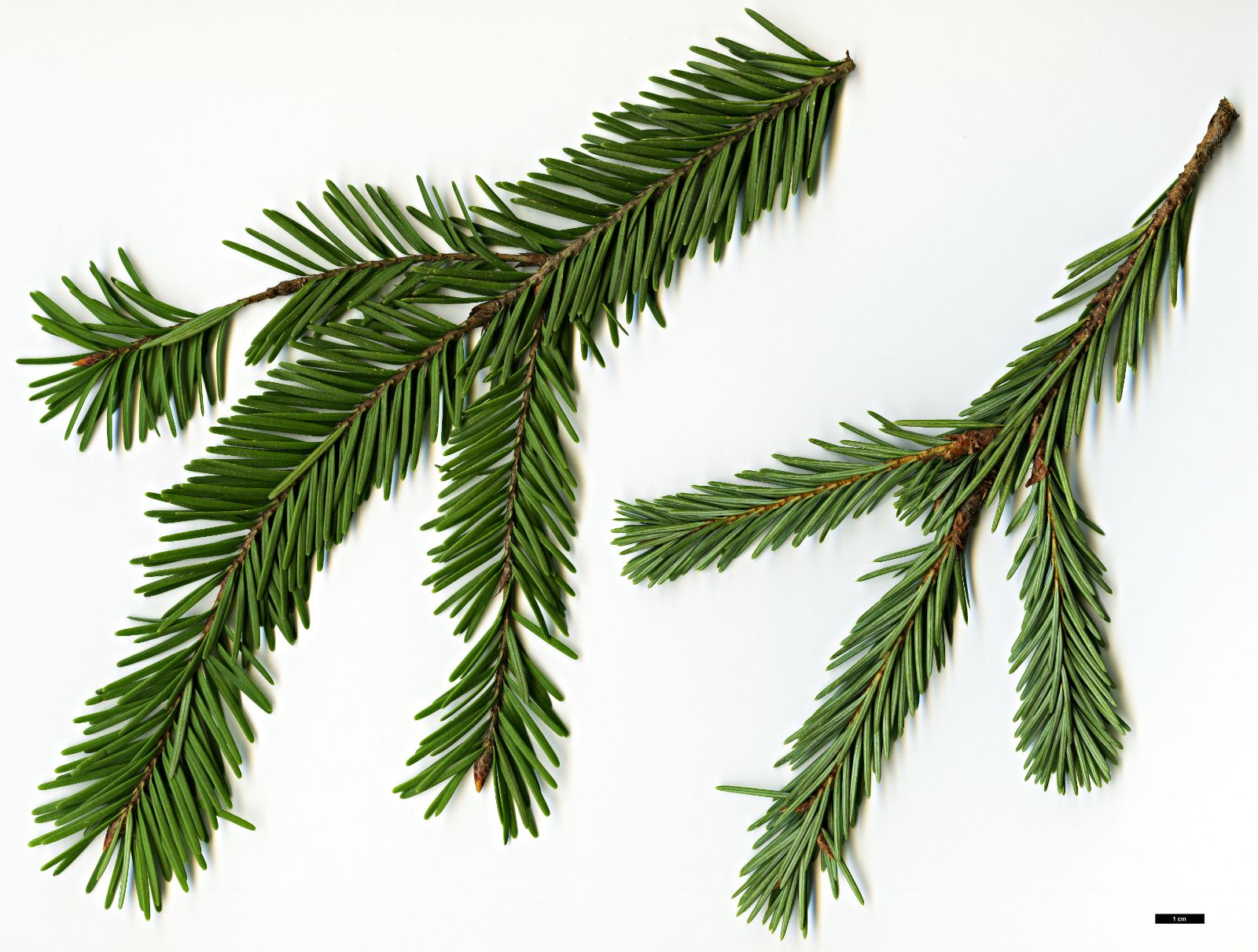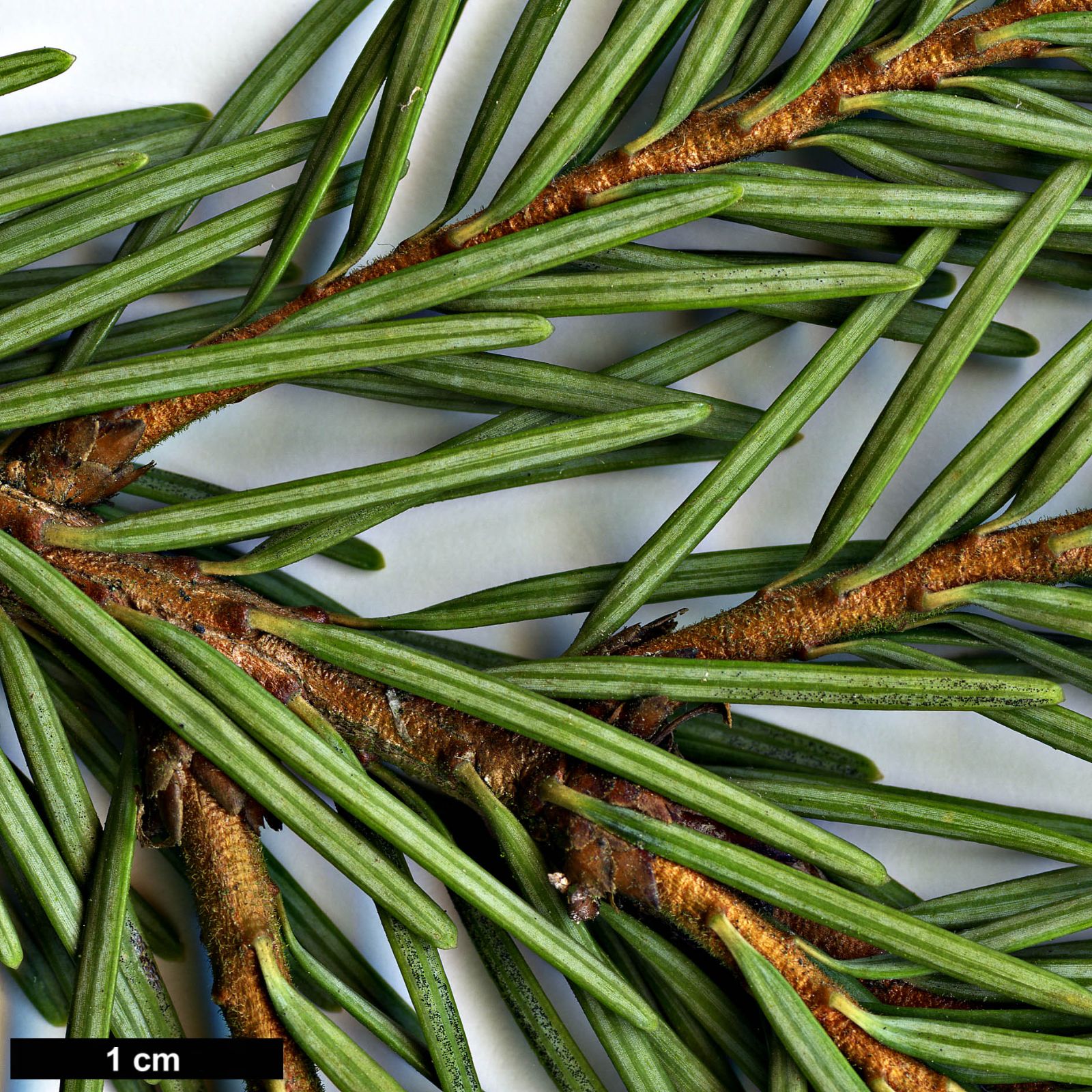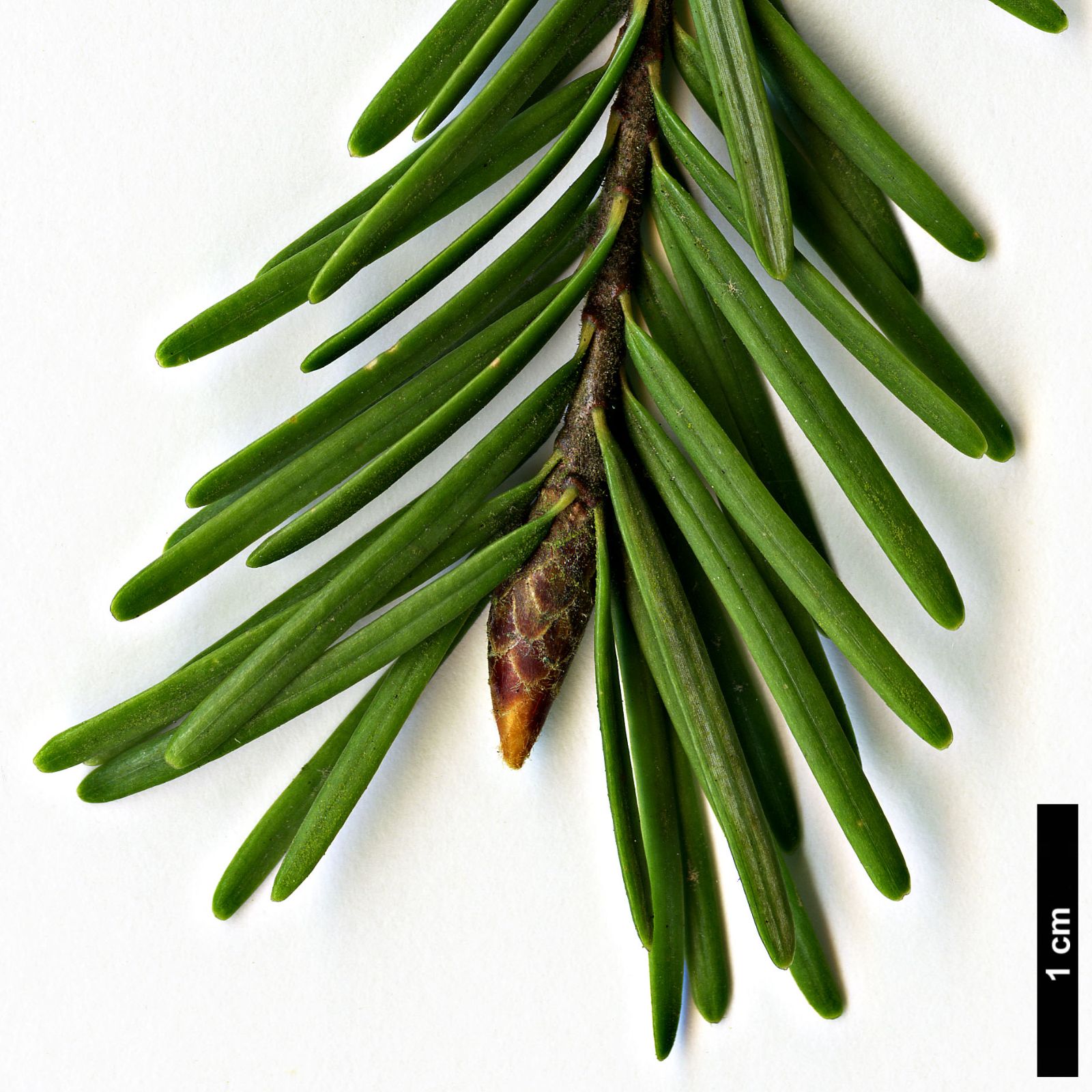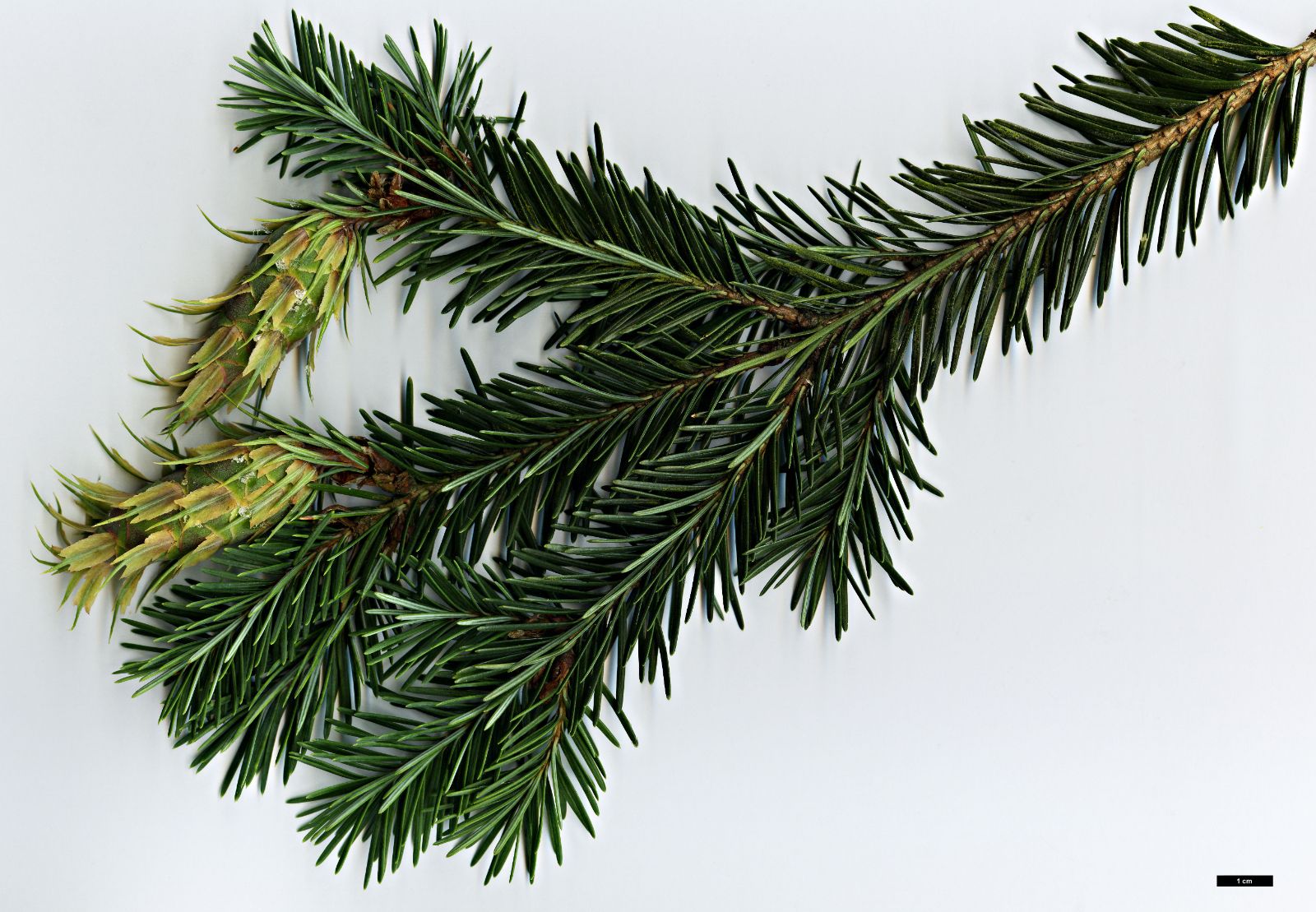Pseudotsuga menziesii
Sponsor
Kindly sponsored by
Dansk Dendrologisk Forening, The Danish Dendrology Society
Credits
Tom Christian & Aljos Farjon (2023)
Recommended citation
Christian, T. & Farjon, A. (2023), 'Pseudotsuga menziesii' from the website Trees and Shrubs Online (treesandshrubsonline.
Genus
Common Names
- Douglas Fir
- Coastal Douglas Fir
- Green Douglas Fir
- Oregon Douglas Fir
- Oregon Pine
- Piño Oregon
- Sapin de Douglas
Synonyms
- Abies douglasii Lindl.
- Abies menziesii Mirbel.
- Pinus taxifolia Lamb.
- Pseudotsuga douglasii (Lindl.) Carr.
- Pseudotsuga taxifolia (Lamb.) Sudw.
Infraspecifics
- 'Agija'
- 'Alber's Elegant Weeping'
- 'Albospica'
- 'Anguina'
- 'Appressa'
- 'Argentea'
- 'Astro Blue'
- 'Aurea'
- 'Aureo Marginata'
- 'Big Flats'
- 'Blue'
- 'Blue Wonder'
- 'Boulder Blue'
- 'Brevibracteata'
- 'Brevifolia'
- 'Caesia'
- 'Caesia Erecta'
- 'Candida'
- 'Cascade'
- 'Cedar Ridge Curly Weeper'
- 'Coenosium Gold'
- 'Coeur d'Alene'
- 'Crispa'
- 'Cross Selection'
- DEEP MOUNTAIN®
- 'Delbert's Weeping'
- 'El Dorado'
- 'Elegans'
- 'Faber'
- 'Fletcheri'
- 'Fort Lewis'
- 'Fournier's Greenspire'
- 'Fraser River'
- 'Fretsii'
- 'Glauca Fastigiata'
- 'Glauca Pendula'
- 'Glenmore Blue'
- 'Gotelli's Weeping'
- 'Graceful Grace'
- 'Hayfork Gold'
- 'Helms'
- 'Hess Blue'
- 'Hillside Gold'
- 'Idaho Weeper'
- 'Kooteney Lake'
- 'Leenderheide'
- 'Lombartsii Pendula'
- 'Longifolia'
- 'Marshall'
- 'Metolius Weeper'
- 'Moerheimii'
- 'Mossman'
- 'Mount Hood Weeper'
- 'Nana'
- 'Oudemansii'
- Pendula Group
- 'Pine Grove Gold'
- 'Serpentine'
- 'Shorty's Blue'
- 'Skyline'
- 'Slavinii'
- 'Slavin's Weeping'
- 'Stairii'
- 'Standishiana Fastigiata'
- 'Standishii'
- 'Stricta'
- 'Suringarii'
- 'Taranto'
- 'Thrift'
- 'Torquis'
- 'Uwe's Golden'
- var. glauca
- 'Variegata'
- 'Viminalis'
- 'Weep Willie'
- 'Whiskey Hill'
- 'White Mountain Weeping'
- 'Wicky's Pinnacle'
- 'Wind Surfer'
- 'Wycoff's Big Blue'
Other taxa in genus
Monoecious evergreen coniferous trees to 90–100(–110?) m tall, dbh to 4–5 m [in cultivation in the UK reaching 66 m tall (2023)]; trunk monopodial, straight, columnar. Bark on large trunks rough and scaly, with deep, longitudinal fissures, dark grey-brown or blackish-grey. Branches spreading horizontally, but lower ones curved downward; crown of young trees broad conical, sometimes with drooping leader, in old trees more columnar or irregular. Branchlets slender, flexible, at first yellowish-green later grey, minutely pubescent in the first year, then glabrous, leaf scars small, circular. Vegetative buds ovoid-conical, acute, c. 10 × 5 mm, not resinous; bud scales triangular, lustrous reddish brown, persisting 1–2 years. Leaves spreading more or less radially, on shaded shoots more pectinate, (1.5–)2.5–3.5(–4) cm long, 1.2–1.5(–1.7) mm wide, more or less petiolate and slightly twisted at base, linear, straight, flattened, obtuse or acute at apex; stomata in two whitish bands separated by a midrib on abaxial (= under) side, lustrous dark green above or more or less glaucous. Pollen cones 1.5–2 cm long, yellow, with red brown perular scales at base. Seed cones pendulous on 0.5–1 cm long peduncles, deciduous, ovoid-conical, obtuse or pointed at apex, 4–9(–10) cm long, 2–4 cm wide with opened scales, green, with yellowish green bracts, ripening in one season to brown or dull grey-brown, with light brown bracts. Seed scales obovate-cuneate, convex, 2–2.5 × 2–2.5 cm at mid-cone; base more or less cuneate. Bracts ligulate, trilobate at apex, with cusp longer than lateral lobes, 2.5–3.5 cm long, exserted, not reflexed, often curved towards cone apex. Seeds ovoid-cuneate, 6–8 × 4–5 mm, light brown, often with dark spots; wings ovate oblong, 9–14 × 5–8 mm, yellowish brown. (Farjon 2017).
Distribution Canada Mexico United States
Habitat This species occurs over a huge area from north to south (55ºN to 16ºN) in western North America, consequently it occupies a variety of climatic zones, landscapes and habitats. Along the coast in British Columbia and the Pacific Northwest the typical form of the species attains its greatest proportions and is a co-dominant or dominant tree in the temperate rainforests from near sea level to 1900 m asl depending on latitude. It profits from the high rainfall, yet occupies better drained sites commonly on slopes or high, no longer flooded river terraces, where it can compete successfully with other conifers, mainly Abies, Picea, Tsuga, and Thuja, especially after fire. Giant trees attain 100 m, and there is evidence of taller trees that were logged in the days when Americans of European descent could see only the timber in them. Somewhat further inland the species grows also in valley bottoms near streams, still attaining great sizes and living to 800–1000 years. These coniferous forests are of similar composition to those on the coast.
USDA Hardiness Zone 5-6
RHS Hardiness Rating H7
Conservation status Least concern (LC)
By any measure Pseudotsuga menziesii is one of the great trees of the world. It occurs over a vast swathe of western North America, from British Columbia in Canada to Oaxaca in Mexico, covering some 39° of latitude and 5100 km, the largest north-south range of any conifer (Debreczy & Rácz 2011). It famously reaches its zenith in the Pacific Northwest where it stands among the tallest growing trees on earth, with individuals over 100 m recorded. Throughout its native range it is valued for its strong, durable timber, for which it has been successfully introduced to every other tree-growing continent, earning the respect and admiration of generations of foresters, sawmillers, architects and builders. It is also a singularly beautiful and impressive tree and has been widely planted as an ornamental (Farjon 2017; Debreczy & Rácz 2011).
By a quirk of history, this cosmopolitan tree’s scientific and English common names – Pseudotsuga menziesii and Douglas Fir – commemorate two men from rural Perthshire, Scotland, who each played a significant role in its modern history. Archibald Menzies trained as a surgeon and sailed to western North America with the Vancouver expedition (1791–1795) where he discovered this and many other species for modern botany. Menzies’ most famous introduction is probably the Monkey Puzzle, Araucaria araucana, obtained during a stopover in Chile, but the bulk of his botanising took place in the Pacific Northwest. He first encountered Douglas Fir at Nootka Sound, on the west coast of Vancouver Island, in 1792 (Fletcher & Samuel 2010). Menzies later advised the young David Douglas before the latter set out on his own travels to the same region for the Horticultural Society. It was Douglas who successfully introduced the conifer that would come to bear his name, in 1826.
The precise origin of Douglas’s collection (or collections) is not known, but it is generally believed to have come from somewhere in northern Oregon (Mitchell & House 1999) thus representing var. menziesii. Invoking the botanical technicality ‘var. menziesii’ demands disambiguation. The vernacular name Douglas Fir applies to P. menziesii as a whole, but there are two varieties: the nominate var. menziesii distributed close to the Pacific coast from near to the Alaskan border in British Columbia south to c. 34°N in coastal California and to c. 36°N in the Sierra Nevada (Hermann & Lavender 1990); and var. glauca, distributed in the Rocky Mountains from northern British Columbia south to New Mexico, and then in increasingly isolated populations south as far as Oaxaca in south-central Mexico (Debreczy & Rácz 2011). P. menziesii var. menziesii is the mainstay of the North American lumber industry and of immense value in other regions, too, and is lauded by dendrologists and foresters the world over; var. glauca is slower-growing and rarely exceeds 50 m, but is by far the more useful of the two in continental climates such as the eastern states where the coastal form is generally not hardy (Jacobson 1996). Thus there are two Douglas Firs, but morphologically, ecologically and culturally these are two very different trees. The vernacular names Coastal, Oregon, or Green Douglas Fir have often been applied to var. menziesii to distinguish it from var. glauca, which in turn is often referred to as the Interior, Rocky Mountain, or Blue Douglas Fir, but increasingly people refer to var. menziesii simply as ‘Douglas Fir’, especially in oceanic climate zones where the type prevails. Hereafter, by referring simply to ‘P. menziesii’ or ‘Douglas Fir’ we are speaking of P. menziesii var. menziesii; when discussing var. glauca we will refer to it specifically.
Douglas’s new introduction would prove a near-instant hit, astonishing everybody with its very fast rate of growth, far beyond any other tree cultivated in Europe at the time (although Abies grandis, which would be introduced by Douglas just a few years later in c. 1831, would soon match it in appropriate areas, as would Sequoia sempervirens, introduced via Russia c. 1843) (Mitchell 1996). Several other collectors, working for nurseries or private consortia of landowners, introduced modest quantities of Douglas Fir seed in the following years – including William Lobb for the Veitch nurseries and John Jeffrey for the Oregon Association, both in the early 1850s – but large-scale seed introductions to Europe, mostly aimed at the forestry markets, would not occur until the 1870s, though these continued for many decades until Sitka Spruce (Picea sitchensis) came to dominate European and especially British conifer production from the 1950s (Fletcher & Samuel 2010). Nevertheless, Pseudotsuga menziesii remains one of the world’s most important timber trees. Its huge size, rapid growth and excellent wood properties make it a choice tree providing knot-free sawn timber of great length. It is used for plywood and construction, both exterior and interior, and its reasonably good durability makes it useful for telegraph poles and railway sleepers and so on. However, the continental var. glauca grows much more slowly and to a more moderate size and yields denser, heavier wood, excellent for cooperage for vats and tanks for breweries and distilleries (Farjon 2017).
Within one hundred years of its introduction, Pseudotsuga menziesii had come to account for the tallest trees in several European countries. Indeed, at one time Douglas Fir was the tallest known tree in the world, but the very largest of these and of Australia’s eucalypts were logged out by the end of the 19th century and the title later passed to Sequoia after the tallest of these were discovered in the 20th century (Mitchell 1996). As befits a tree of such pedigree, a great deal has been written about P. menziesii during the past 200 years. In 1883, Thomas Hunter marvelled at the ‘wonderful adaptability’ of this tree in Perthshire and in an essay on the Scone estates lamented the fate of its namesake, David Douglas, who was born there in 1798 and later met an untimely and unpleasant end in a Hawaiian bull pit in 1834, dramatically curtailing the life and career of a man whose contributions to horticulture and botany had already guaranteed his legacy (Hunter 1883).
Although Douglas Fir was found to grow well throughout western Europe, Scotland perhaps came to be more inextricably associated with it than anywhere else, partly thanks to the association of Menzies and Douglas – several trees from Douglas’s original introduction still grow in some Scottish estates, including at Scone Palace, where Douglas trained as a gardener, and at Dawyck and Drumlanrig – but also because the cool, humid, oceanic climate suited the early introductions particularly well. Some of the finest individuals and stands of Douglas Fir that exist outside its native range have consistently been found in Scotland. For Henry Elwes, there was a greater concentration of large examples at Murthly Castle, Perthshire, than anywhere else in Scotland, and they remain the dominant feature of the landscape here. Planted at 8 yard (7.3 m) spacing along a series of stepped and winding terraces in the 1840s, in the 20th century the trees were thinned so as to stand 16 yards apart, and the effect is one of the most beautiful stands of Douglas Fir to be seen anywhere in Britain (TC pers. obs.). It is some while since any of the Murthly Douglas Firs were record breaking trees, but in the past they included some of the largest: ‘One, planted in 1847, was on 11th August 1892 [26.3 m × 0.85 m dbh] and on 24th March 1900 [29.6 m × 0.95 m dbh]. A great many others were of about the same size […] Mr Fothringham states that all these measurements were taken by sending men or boys up the trees, and not with a dendrometer’ (Elwes & Henry 1906–1913). These days the tallest, last measured by Owen Johnson in 2017 and with much greater regard to health and safety, was pushing 56 m (Tree Register 2023).
Indeed, European dendrologists and foresters have always followed Douglas Fir’s progress most keenly, establishing league tables of the tallest, widest, and fastest-growing examples in essays and pamphlets and in the proceedings of the occasional RHS Conifer Conferences (e.g. Chittenden 1932). Since the founding of the Tree Register of Britain and Ireland (TROBI) in 1988, P. menziesii has consistently been one of the tallest-growing tree species in these nations, latterly the tallest by some comfortable margin, as TROBI’s recorders began to look beyond the traditional arboretum setting and into the sheltered, wooded glens of the Scottish Highlands, Snowdonia, etc. Individual trees, current or former record breakers or otherwise distinguished, have been immortalised in numerous publications, mostly in the wake of Thomas Pakenham’s trendsetting Meetings With Remarkable Trees (Pakenham 1996) which itself features many fine examples.
Nevertheless, it would take many decades, and many new introductions from different areas, to paint a fuller picture of this tree’s performance and potential in cultivation, particularly in productive forestry. Meaningful provenance trials were established by the British Forestry Commission from the 1920s, by which time differences were clear to see in the range of plantations established from ad hoc provenances (Fletcher & Samuel 2010). These and other early experiments quickly confirmed that coastal populations (var. menziesii) were far superior to interior populations (var. glauca) in many areas of western Europe, while later experiments, established in 1953–54 and 1970–72, sought to give greater resolution about the most appropriate provenances of var. menziesii for silviculture in Britain and these experiments have strongly influenced commercial forestry here ever since. Lavender & Hermann (2014) take a global view, discussing the results of provenance trials in 24 countries, mostly in Europe but also in Taiwan, Australia and New Zealand, and summarise the latest efforts of breeding and improvement programmes for commercial forestry in North America, Europe and New Zealand.
Pseudotsuga menziesii is generally regarded as a tree with significant potential in a changing climate, particularly in Europe, but realising this potential may require a more nuanced approach to provenance trialling and site selection than has previously been adopted. For example, Fletcher & Samuel (2010) concluded that provenances from inland British Columbia and northern California, where summer temperatures are higher and precipitation lower, or at least more seasonal, were ‘inferior’ within broadly defined UK climate zones to provenances from coastal Washington and the western slopes of the Cascades, but some of the best performing young trees at Kew, infamously hotter and drier than it once was, come from the Okanagan Valley in British Columbia. This is over 250 km due east from Vancouver and an important centre of Canadian viticulture and pomiculture; trees from this provenance at Kew were totally unphased by the record-breaking heatwave and associated drought of summer 2022, appearing vigorous and healthy when seen in early 2023 (pers. obs.). Certainly climate change adaptation is an area of active and accelerating research in commercial forestry, and as one of the most important lumber species in North America, and accounting for over 800,000 ha of commercial forest in Europe, P. menziesii is one of the more intensely researched species (Lavender & Hermann 2014; Eilmann et al. 2013).
Be that as it may, the romantic connotations of exploration and discovery associated with the early introductions – not to mention the sheer size – of coastal var. menziesii continues to resonate among dendrologists and foresters, especially in a UK context. Bean’s advice, given originally in his first edition of 1914 and repeated in each of the seven subsequent revisions up to 1976, that ‘to see this tree in its finest condition and in its greatest numbers one must visit the Perthshire properties’ (Bean 1976) remains reasonably sound, but over a century on and with original trees nearing 200 years old, even a Perthshire native is obliged to admit that there are equally astonishing examples in other Scottish counties, especially Argyll and Inverness-shire; in Wales, especially Snowdonia; and in England, especially in Cumbria, Cornwall and Devon, to say nothing of the many superb trees growing in most western European nations, in New Zealand, and in appropriate parts of Australia (Tree Register 2023; monumentaltrees.com 2023).
The tallest ex-situ trees include individuals 69.6 m × 1.4 m dbh in New Zealand; 67.5 × 1.5 m in Wales; 67.1 m × 1.3 m in Germany; 66.4 m × 1.5 m in Scotland; and 63.5 m × 1.3 m in Spain. These all represent the tallest known trees in each country, except Spain where the record represents the tallest conifer (Sillett et al. 2021). Currently (August 2023) the website monumentaltrees.com gives trees exceeding 60 m in all these countries and also in France, Slovenia, Czechia, Italy, Ireland and Ukraine (monumentaltrees.com 2023) and there are probably undiscovered examples of similar dimensions in other places. The tallest of a group of Douglas Firs growing in central Jutland, Denmark, was 57 m in 2017 and this is probably the tallest tree in mainland Europe north of the Harz Highlands of northern Germany (P. Hoffmann pers. comm. 2023).
All these cultivated trees pale in comparison, however, to the largest extant trees recorded from the Pacific Northwest where the best stands regularly exceed 90 m (Sillett et al. 2021) and individuals within touching distance of 100 m are reported (monumentaltrees.com 2023). The latter record has historic precedent: in 1930 a tree known as the Mineral Tree fell – it was measured at 119.78 m tall with a dbh of 4.57 m and was aged to 1030 years (Debreczy & Rácz 2011).
Among temperate evergreens it is hard to conceive of a statelier tree than Pseudotsuga menziesii. Several other species contest the title in their natural state, but in cultivation Douglas Fir is perhaps without equal. Bean’s advice, that to reach its full potential Douglas Fir requires abundant rainfall and ‘at least a moderately good soil’ (Bean 1976) holds true, but its climatic requirements are more nuanced than once thought and provenance can have a significant bearing on success. It will not thrive on soils that are excessively dry or wet, nutrient poor or compacted, and alkaline soils are especially unsuitable, but in most congenial situations Douglas Fir will grow quickly into a vigorous, single-stemmed tree of singular elegance. It is unforgiving toward those who would plant it in too restricted a space, while in exposed locations it will often lose its leading shoot once it reaches a critical height. Largely a pioneer species, Douglas Fir is light demanding; planted in shade it will soon become leggy and lacklustre (Fletcher & Samuel 2010; Bean 1976).
At face value, an enormous number of cultivars have been selected since its introduction to cultivation, but many named cultivars are nothing more than lookalike witches’ brooms that have been selected in the past few decades, too many of them named before adequate testing or propagation, let alone distribution (Hatch 2021–2022). Several of the larger cultivars are are genuinely distinct, but some of the oldest were named based on minor differences now accepted as part of the natural variation, e.g. ‘Longifolia’, or on the basis of (at the time) novel provenance, e.g. ‘Standishii’, ‘Taranto’; the practice of naming such selections ceased long before the practice of listing them in books (or websites). Many of the earliest cultivars were originally described as botanical varieties or formae, which Augustine Henry sensibly dismissed for being based on ‘trifling and inconstant’ characters (Elwes & Henry 1906–1913). Extant selections that offer something genuinely different tend to distinguish themselves either by habit or foliage colour (usually bluish hues, probably selected from var. glauca although this is not always recorded) or both. Several modern cultivars are excellent horticultural selections: among the best blue forms are ‘Arrowhead Blue’, ‘Blue Wonder’, ‘Hess Blue’ and ‘Wycoff’s Big Blue’. Good weeping selections include ‘Graceful Grace’ and ‘Idaho Weeper’ (both rather glaucous, too). Several clones are grown under old names such as ‘Fastigiata’ and ‘Pendula’, some excellent, others less so; caution is advised. The cultivar entries below are listed A–Z, but with all extreme dwarfs and witches’ brooms (remaining <1m tall and broad after ten years) grouped together under the subheading ‘Dwarf Cultivars’; such selections are mostly distributed among a handful of dedicated collectors and rarely enter commerce and several are probably already extinct. The cultivar entries have been compiled with the help of several sources but especially the authoritative RHS Encyclopaedia of Conifers (Auders & Spicer 2012).
'Agija'
A leaderless, slow growing pyramidal plant with thin, contorted branches and pale green foliage. In ten years 1.5 × 1 m. Raised as a seedling in 2001 by the late Aris Auders, Latvia, and named after his wife (Auders & Spicer 2012).
'Alber's Elegant Weeping'
A narrow, graceful, weeping plant raised by Sam Pratt, Washington, and named for his mentor Dr John Elbers (Hatch 2021–2022).
'Albospica'
Young foliage nearly pure white, greening up after several weeks. Raised from seed before 1920 by C. van Geert, Kalmthout Arboretum, Belgium, but probably not now in cultivation (Auders & Spicer 2012).
'Anguina'
A sparsely branched plant with ‘only a few chaotically twisted, secondary snake-like branches’ (Auders & Spicer 2012). At up to 5 cm long the typical green needles are longer than the typical maximum for the species. ‘Anguina’ was raised prior to 1923 in Endsleigh, Devon, UK but has probably been lost to cultivation (Hatch 2021–2022).
'Appressa'
An unusual selection with the pale glaucous-green leaves adpressed to the new shoots (Hatch 2021–2022) a trait sometimes observed in plants of var. glauca. Raised by von Schwerin in 1901 but probably lost to cultivation (Auders & Spicer 2012).
'Argentea'
Described as ‘An upright plant with silvery blue-white needles’ (Auders & Spicer 2012). Raised c. 1875 by M. Koster & Sons, Netherlands, but probably lost to cultivation.
'Astro Blue'
Synonyms / alternative names
Pseudotsuga menziesii 'Austro Blue'
A dense, broadly pyramidal tree with intense, pale glaucous leaves. It was raised by the Vermeulen Nursery of New Jersey in 1968 who originally named it ‘Compacta Glauca’ (Hatch 2021–2022). This name was invalid in Latin form as it was published after 1959, besides which the name ‘Compacta Glauca’ had already been used before 1902 by the Ansorge Nurseries, Germany for a different clone (see under Dwarf Cultivars) (Auders & Spicer 2012).
'Aurea'
A plant with pale yellowish new growth, becoming whitish later, raised from seed by A. Sénéclauze, France, c. 1862; ‘Later authorities including Beissner (1909), von Schwerin (1922) and Krüssmann (1960) referred [this name] to a different plant originating from Cultoquhey near Crieff, Scotland, described as having the young growth sometimes a clear primrose-yellow in July’ (Auders & Spicer 2012).
'Aureo Marginata'
An upright but otherwise lax tree, to 3 × 2 m in ten years. The green leaves have white margins, the effect best when it is grown in some shade. Introduced to commerce by Stanley & Sons Nursery of Oregon, in 2005, but the cultivar name in Latin form is invalid unless published before 1959 (Auders & Spicer 2012).
'Big Flats'
A vigorous tree with pendent branches and long glaucous needles. Selected in 1955 by Dick Fennechie from the New York State Nursery in Big Flats, New York (Auders & Spicer 2012). It was still in American commerce in the late 1990s (Jacobson 1996).
'Blue'
A tree with a habit like that of the species but clear blue foliage. Received by Iseli Nursery from Bush Nursery, Oregon before 1985 (Auders & Spicer 2012).
'Blue Wonder'
Synonyms / alternative names
Pseudotsuga menziesii 'Lombarts'
Pseudotsuga menziesii 'Lombartsii Glauca'
A medium-sized tree of conical habit with strongly glaucous foliage – ‘among the brightest and best blues’ for American authority Larry Hatch – the leaves 3–3.5 cm long and in ten years plants are 2–3 × 1.5 m. The name is problematic. First raised from seed by P. Lombarts in the Netherlands in 1910, it was listed in the 1936 Lombarts catalogue as ‘Lombartsii Glauca’ and then in 1958 as ‘Blue Wonder’, but in the intervening period it was listed simply as ‘Lombarts’ in the 1938 catalogue and as ‘Lombarts’ and ‘Blue Wonder’ by den Ouden in 1940 (Hatch 2021–2022; Auders & Spicer 2012). Perhaps the nursery finally settled on ‘Blue Wonder’ to clear up some of this confusion.
'Boulder Blue'
A slow-growing upright plant with leaves a good pale blue. To 1.5 × 1 m in ten years. Known in American cultivation since before 2000 (Auders & Spicer 2012).
'Brevibracteata'
This name was originally used as a botanical variety, described in 1841 covering plants occasionally found in the wild with very short bracts on the female cones. As a cultivar, the name (probably invalidly) applies to a plant listed by Herm. A. Hesse Nurseries in 1962 (Auders & Spicer 2012).
'Brevifolia'
Not to be confused with the exceedingly rare Pseudotsuga sinensis var. brevifolia, this P. menziesii cultivar is a rather slow-growing tree with stiff, radially arranged pale green leaves, 0.6–1.3 cm long, densely set on the shoot with an occasional leaf pointing backwards. Raised from seed at the Elvaston Nurseries, near Derby, UK, before 1875 (Auders & Spicer 2012; Bean 1976), a tree at the Sir Harold Hillier Gardens, Hampshire, UK, had reached 20.8 m × 54 cm dbh by 2020 (Tree Register 2023).
'Caesia'
This name was first applied as a botanical variety by von Schwerin in 1907, to cover glaucous plants in the wild in British Columbia. Some authors consider var. caesia to represent trees intermediate between var. menziesii and var. glauca, but the described variation falls within the concept of var. glauca adopted here (see taxonomic note in that article). The name was later used as a cultivar for a single clone (Auders & Spicer 2012).
'Caesia Erecta'
Like plants once labelled var. caesia (see ‘Caesia’ above) ‘Caesia Erecta’ has somewhat glaucous grey-green leaves, often pectinately arranged on glabrous to subglabrous shoots, but a more erect branching structure (Hatch 2021–2022). It was first recorded by von Schwerin c. 1922 but is probably not now in cultivation (Auders & Spicer 2012).
'Candida'
A form with the young foliage silvery white, turning green in its first winter and darker again in the second. It was found in Waterford, Ireland, and recorded in the third edition of Dallimore & Jackson’s Handbook of Coniferae and Ginkgoaceae (1948) and subsequently (Dallimore & Jackson 1966) but has probably been lost to cultivation (Auders & Spicer 2012).
'Cascade'
A vigorous weeping tree with green foliage raised by Mark Weiss and put into commerce by Stanley & Sons Nursery, Oregon, USA in 2006 (Hatch 2021–2022; Auders & Spicer 2012).
'Cedar Ridge Curly Weeper'
A wide-spreading, weeping plant with oddly twisted and curled branches and dark green foliage (Auders & Spicer 2012).
'Coenosium Gold'
A moderately slow-growing plant of upright habit with golden-yellow foliage, to 2 × 1 m in ten years. Raised before before 1999 in the eponymous Coenosium Gardens, Washington, USA (Auders & Spicer 2012).
'Coeur d'Alene'
Selected in or near the eponymous city in Idaho c. 1990, this selection of var. glauca has grey needles and forms a dense, pyramidal, very hardy tree (Jacobson 1996).
'Crispa'
A tree with sickle-shaped leaves, somewhat bluish on the young growth, raised from cultivated seed of var. caesia (see ‘Caesia’) before 1919 by von Schwerin but probably now lost to cultivation (Auders & Spicer 2012).
'Cross Selection'
A slow-growing selection with short greyish-blue leaves, to 2 × 1 m in ten years. Raised by Jim Cross of Environmentals Nursery, New York, and in commerce by 2009 (Auders & Spicer 2012; Hatch 2021–2022).
DEEP MOUNTAIN®
The registered trademark (without a cultivar name) for seed-raised plants of densely pyramidal habit, deep green leaves and late bud-break, improving frost resistance in cold climates. Young plants can grow up to 30 cm per year. Listed by Carino Nurseries, Indiana, Pennsylvania in 2004 (Hatch 2021–2022).
'Delbert's Weeping'
A selection listed by Iseli Nursery, Oregon, in 1983, described as having gracefully arching branches and very dark green leaves by Auders & Spicer (2012).
'El Dorado'
A relatively recent introduction found by Richard Haslebacher and Lalo Villarreal of Woods Creek Horticultural in Oregon. ‘El Dorado’ is typical of the species but with the young growth rich golden-yellow; the parent plant apparently produces yellow seedlings (Hatch 2021–2022; coniferkingdom.com 2023).
'Elegans'
A small, irregularly but densely branched tree with pendulous, horizontal and ascending branches and rather short grey-glaucous leaves. To 3 × 2 m in ten years. Recorded by Beissner in 1887 (Auders & Spicer 2012).
'Faber'
A selection with the youngest shoots bearing golden-yellow leaves (cf. ‘El Dorado’, above). Raised in 1916 by H.H. Faber, Illinois (Auders & Spicer 2012).
'Fletcheri'
A shrubby selection of var. glauca (Bean 1976) forming a broad, flat-topped or globose bush with somewhat radially arranged grey-green leaves. It is potentially of moderate growth when young and may reach 1 × 1.5 m within ten years but soon slows right down, and after many decades old plants may only measure 1–3 m tall, but will almost always be wider than tall. It was one of two similar seedlings raised at the Lock King Nursery, UK and introduced by Fletcher Brothers in or before 1915; the bluer selection was named ‘Nana’, but it never seems to have enjoyed the popularity of ‘Fletcheri’, which for the American authority Larry Hatch remains one of the best of the dwarf selections (Auders & Spicer 2012; Hatch 2021–2022).
'Fort Lewis'
A narrow plant with green foliage of good vigour, with annual growth up to 30 cm. Origin and ultimate size not recorded (Hatch 2021–2022; Auders & Spicer 2012).
'Fournier's Greenspire'
A slow-growing plant with a compact pyramidal to columnar habit and somewhat contorted stems; to 2 × 1 m in ten years (Auders & Spicer 2012). A ‘perfect Christmas tree’ says Hatch (2021–2022). In US commerce since 2002.
'Fraser River'
A name listed by George Jackman & Son, UK, in 1934 for a selection of var. glauca from somewhere on the Fraser River in British Columbia (Auders & Spicer 2012). The name perhaps represented nothing more than the provenance.
'Fretsii'
A small to medium sized, slow-growing tree, broadly conical in outline and often relatively sparsely branched, with short, radially arranged dark green leaves. Raised before 1905 by G. Frets & Son, the Netherlands (Auders & Spicer 2012). In the UK there are examples to 22 m × 71 cm dbh (2019) at RHS Garden Wisley, Surrey, and 20 m × 76 cm (2017) at Pitcarmick, Perthshire (Tree Register 2023) but it is rarely propagated or planted now.
'Glauca Fastigiata'
A narrowly pyramidal tree (at least in youth) with rich glaucous foliage raised in 1913 in Rochester, New York. It is distinct from the ‘Fastigiata’ raised in Britain (see above) (Hatch 2021–2022).
'Glauca Pendula'
A selection of var. glauca with more or less horizontal branches and pendent branchlets raised before 1891 from American seed by Simon-Louis Frères, France (Hatch 2021–2022). It can be quite vigorous; in 2002 a plant at the Sir Harold Hillier Gardens, UK, had reached 7.7 m × 15 cm dbh after c. 25 years while another at Bute Park, Cardiff, was 5 m after 15 years in 2005 (Tree Register 2023).
'Glenmore Blue'
Selected by R.E. More in 1948 from a wild tree in Jefferson County, Colorado, for the good vivid blue colour of its leaves (Auders & Spicer 2012).
'Gotelli's Weeping'
Synonyms / alternative names
Pseudotsuga menziesii 'Gotelli's Pendula'
A naturally leaderless shrubby plant with grey-green leaves which forms a spreading mat unless staked. Relatively vigorous, with annual growth to 30 cm. Raised in the United States prior to 1980 (Auders & Spicer 2012).
'Graceful Grace'
An elegant, narrow, weeping tree that does not require staking; the unusually long leaves are a good glaucous green (Auders & Spicer 2012; Jacobson 1996). There is some confusion as to its origin, with Auders & Spicer (2012) and Hatch (2021–2022) giving quite different accounts. Potentially quite vigorous under the right conditions – Auders & Spicer (2012) suggest 2–3 × 1–2 m after ten years – an example at the Sir Harold Hillier Gardens is much slower, in 2007 it was 2.4 m tall after 23 years (Tree Register 2023).
Beware of confusion with ‘Grace’ (see under dwarf cultivars).
'Hayfork Gold'
A semi-dwarf selection of conical habit and slow growth, raised by Bill Wilson and put into commerce by 2006 (Auders & Spicer 2012).
'Helms'
A slow-growing plant of upright habit with pale green leaves. Annual growth 10–15 cm (Auders & Spicer 2012).
'Hess Blue'
Synonyms / alternative names
Pseudotsuga menziesii 'Hess Select'
Pseudotsuga menziesii 'Hess' Select Blue'
Pseudotsuga menziesii 'Select Blue'
Introduced by the Hess Nurseries of Cedarville, New Jersey (nothing to do with the Hesse Nursery of Germany) in 1977, for Jacobson and Hatch this is one of the best of the glaucous selections, with bright, waxy, bright blue leaves (Hatch 2021–2022; Jacobson 1996). Of moderate vigour, to 2 × 1 m in ten years (Auders & Spicer 2012).
'Hillside Gold'
Raised at Hillside Gardens, Pennsylvania, c. 1970. Jacobson described this as ‘a tree with a golden cast’ and ‘extremely rare’ (Jacobson 1996). Auders & Spicer describe what sounds like a rather different plant under this name: ‘A slow-growing pyramidal plant with blue-green (chartreuse) foliage turning green then yellow in winter. In ten years 3 × 1.5 m. Received by Iseli Nursery, OR, USA from Hillside Gardens, PA, USA in 1981’ (Auders & Spicer 2012) whilst Hatch (2021–2022) says ‘gold suffused or tinged’.
'Idaho Weeper'
Synonyms / alternative names
Pseudotsuga menziesii 'Carnefix Weeper'
Pseudotsuga menziesii 'Carnefix Weeping'
Pseudotsuga menziesii 'Idaho Weeping'
Pseudotsuga menziesii 'Iseli Weeping'
Pseudotsuga menziesii 'Pendula Idaho'
A variable selection of var. glauca (albeit with not particularly glaucous foliage) with a contorted leader and somewhat pendulous branches, tending to grow broader than tall unless staked when young. Annual growth 30–50 cm. Found in Idaho by Warren Carnefix then named in Oregon 1989, it was in commerce by 1992 (Auders & Spicer 2012; Jacobson 1996). There is some uncertainty around the correct name; Hatch (2021–2022) uses ‘Carnefix Weeping’ while Jacobson (1996) and Auders & Spicer (2012) prefer ‘Idaho Weeping’ and ‘Idaho Weeper’ respectively. Hatch names this among his top selections of Pseudotsuga menziesii.
'Kooteney Lake'
A pendant, sparsely branched plant with dark green leaves, found as a budsport Kooteney Lake, in the Rockies of southern British Columbia, Canada. Appeared in the 1983 catalogue of Horstmann Nurseries, Germany (Auders & Spicer 2012).
'Leenderheide'
Similar to the more widely grown ‘Serpentine’ (see below) this forms a moderately vigorous plant of upright habit with variably curled and twisted stems and green leaves. To 3 m in ten years. Raised in the Netherlands prior to 2005 (Auders & Spicer 2012).
'Lombartsii Pendula'
A slow growing plant, after many years a tall tree with pendulous branches and pale green needles to 2.5 cm long. Raised from seed in 1910 by P. Lombarts, the Netherlands (Hatch 2021–2022; Auders & Spicer 2012).
'Longifolia'
Recorded by Cooper in the proceedings of the 1931 RHS Conifer Conference (Chittenden 1932) and noted as being a vigorous tree with particularly long needles (to 37 mm), in modern terms this would be regarded as falling comfortably within the variation of the species and the name becomes superfluous.
'Marshall'
A slow-growing, densely branched, conical selection of var. glauca, raised c. 1930 in Colorado and introduced by the Marshall Nursery, Nebraska. A plant at the Morton Arboretum was 2.3 m after 14 years (Jacobson 1996).
'Metolius Weeper'
Discovered before 2013 along the Metolius River in Oregon by Art Anderson and Tim Moriarty, and apparently also by Frank Hoffman in the same year. The original tree was a tall, sturdy plant with a narrow crown and pendulous branches but has since been killed by fire (Hatch 2021–2022).
'Moerheimii'
An altogether rather irregular plant, generally of compact, upright growth with a proportion each of straight and curved or bowed branches and of irregularly sickle-shaped glaucous green leaves to 4 cm long. Raised by B. Ruys, Royal Moerheim Nursery, the Netherlands in 1912 (Hatch 2021–2022; Auders & Spicer 2012). Two trees at the Sir Harold Hillier Gardens, Hampshire, UK were 19.2 m × 35 cm dbh and 10 m × 24 cm dbh in 2017, but their ages are unknown (Tree Register 2023).
'Mossman'
A name of uncertain application, listed by Suncrest Gardens, PA, USA in 1993 without a description (Auders & Spicer 2012). The same material is possibly in circulation under the following additional names:
- ‘Mossman Pendula’ Listed by Peace of Mind Nursery Inc., OR, USA in 2009
- ‘Mossman Weeping’ Listed by Yellowood Nursery, USA in 2009
'Mount Hood Weeper'
A vigorous weeping plant found on Mt Hood, Oregon (Hatch 2021–2022).
'Nana'
Despite the name, this clone does not qualify as a ‘dwarf cultivar’ as defined here, that is to say remaining less than 1 × 1 m in ten years. Those very slow-growing forms, mostly derived from nearly identical witches’ brooms, are treated under the heading ‘Dwarf Cultivars’. In contrast to most of those, ‘Nana’ is a comparatively vigorous plant of strong growth, conical habit, with stiff, somewhat glaucous-green leaves arranged radially around the shoots (Auders & Spicer 2012). It is similar to and of the same origin as ‘Fletcheri’, having been raised before 1895 in Lock King Nursery, UK, and introduced to the trade by Fletcher Brothers, who originally sold these plants under the name ‘Fletcheri’ until Hornibrook renamed the second clone ‘Nana’, distinguished by its longer, bluer, more radially arranged leaves (Hatch 2021–2022).
'Oudemansii'
A compact, pyramidal plant selected as a seedling at the Schovenhorst Pinetum, the Netherlands, by den Ouden & Sons in 1940. The first order branches are strongly horizontal, the leaves radially arranged, rather short (1.5–2 cm), a rich bluish-green, though not especially glaucous (Hatch 2021–2022). A tree growing under this name in the Heather Garden, part of the Valley Gardens in Windsor Great Park, UK, was 12 m × 34 cm dbh in 2021 (Tree Register 2023).
Pendula Group
Synonyms / alternative names
Pseudotsuga menziesii 'Pendula'
Some permutation of the name ‘pendula’ has been suffixed to Pseudotsuga menziesii since at least 1853. It has been applied to variably pendulous plants rasied from seed, first distinguished at the rank of variety (Abies taxifolia var. pendula Neumann (1853)) with later authors amending Neumann’s variety to the rank of form. Curiously, no combination has ever been published under Pseudotsuga menziesii itself, but many iterations appeared under earlier names such as Abies taxifolia, Pseudotsuga douglasii, P. taxifolia, etc. (Plants of the World Online 2023).
Nurseries later applied the name to more exaggeratedly weeping forms, but even by the late 19th century multiple clones were circulating under the name. Auders & Spicer (2012) advised against the use of the name as a stand alone cultivar and plants belonging to var. menziesii previousy treated as ‘Pendula’ could more logically be placed in Pendula Group. The best pendulous forms now bear unique names (e.g. ‘Cascade’, ‘Glauca Pendula’, ‘Graceful Grace’, and ‘Idaho Weeper’); those belonging to var. menziesii could logically be placed in Pendula Group but their unique names should be maintained, whilst those belonging to var. glauca should probably not be placed in the same group.
'Pine Grove Gold'
A vigorous tree of typical habit, the young spring growth golden-yellow, soon turning pale green, and then darker green by winter. Introduced by the Cedar Ridge Nursery, New Jersey, before 2008 (Auders & Spicer 2012).
'Serpentine'
A slow-growing irregularly contorted plant with twisted branches and branchlets. To 3 m in ten years. Listed by Edwin Smits, the Netherlands in 2009 (Auders & Spicer 2012).
'Shorty's Blue'
A slow-growing, upright, compact, pyramidal plant with rich blue foliage. In ten years 2 × 1 m. Listed by Bucholz & Bucholz Nursery, Oregon in 2009 (Auders & Spicer 2012).
'Skyline'
A vigorous tree of strong growth with unusual, sparse, curved and twisted branches like Picea abies ‘Virgata’, and with glaucous-green leaves. 3–5 × 1.5–3 m after ten years. Otto Solburger found it as a sport on Skyline Boulevard near Portland, Oregon, sometime before 1986 (Auders & Spicer 2012).
'Slavinii'
A rather small, conical cultivar, densely branched low down with a broad base and narrowing abruptly to a spire like top. The bright green leaves are rather short and crowded on the shoots. To 1.8 × 1.3 m in ten years. Discovered as a seedling in 1914 near Cobb’s Hill Reservoir, Rochester, New York, and named in 1932 for horticulturist Bernard H. Slavin (1873–1960). Jacobson described it as ‘very rare’ by the late 1990s (Auders & Spicer 2012; Jacobson 1996). Apparently the original name was ‘Pyramidata Slavinii’ but Krüssmann shortened it in 1955 (Hatch 2021–2022).
'Slavin's Weeping'
A large tree of strong growth with horizontal first order branches and pendulous second order branches, branchlets etc. Found in the New York State Parks by J.W. Kelly in 1977 (Auders & Spicer 2012).
'Stairii'
A tall tree of normal habit and size with creamy-yellow new growth, turning pale green in summer and darkening in autumn. It was found before 1871 near Castle Kennedy on the Earl of Stair’s estate in Wigtownshire, Scotland (Auders & Spicer 2012; Bean 1976). The tree illustrated below, growing at Cortachy Castle in Angus, Scotland, was 28 m × 60 cm dbh in 2017; the largest confirmed example known in the UK (Tree Register 2023).
'Standishiana Fastigiata'
Branches spreading at the base then turning upwards forming a column (Auders & Spicer 2012). Recoreded by Sénéclauze in 1867.
'Standishii'
Synonyms / alternative names
Pseudotsuga menziesii 'Standishiana'
A tree raised c. 1855 in the Standish Nursery, UK ‘from English seed’ according to Auders & Spicer (2012). Its distinguishing features are not recorded, but it may be that, at the time, raising Douglas Fir from home grown seed was deemed sufficiently novel to provide a unique moniker for marketing purposes. In the absence of any distinguishing features the name has long been superfluous.
'Stricta'
Synonyms / alternative names
Pseudotsuga menziesii 'Verticillata Stricta'
A slow-growing, very narrow plant with first order branches rising at a steep angle, themselves branching near their tips. In many respects it is another iteration of ‘Fastigiata’ but of distinct origin, having been raised in France by Sénéclauze c. 1862 (Auders & Spicer 2012).
'Suringarii'
There is some uncertainty regarding the distinguishing features of this plant, discovered in 1927 by von Schwerin in the park at Renkum, near Wageningen, The Netherlands. Auders & Spicer (2012) suggest a potentially large tree of normal habit but with the needles all curved downward beneath the plane of the shoot, while Hatch (2021–2022) suggests it is the branches that curve back on themselves. Perhaps it was both. We may never know for sure as it appears it was never propagated and the original tree destroyed in a bombing raid in 1944 (Hatch 2021–2022).
'Taranto'
Described by Auders & Spicer (2012) as ‘a very tall-growing cultivar with a straight trunk, downward curving branches and bluish green needles’ it seems doubtful that this cultivar differs in any significant way from the type. The name may originally have been applied simply to identify a seed source, in this case the famous gardens of Villa Taranto on Lake Maggiore, northern Italy.
'Thrift'
A broadly pendulous plant with blue-green foliage, up to 1.5 tall and broad in ten years. Raised in the United States by Mark Dusek in 1980 (Auders & Spicer 2012).
'Torquis'
Synonyms / alternative names
Pseudotsuga menziesii EMERALD TWISTER
An upright plant with curving, twisting, undulating, at times corkscrew-like branches with normal deep green foliage. In ten years 3 × 2 m. Considered by Auders & Spicer (2012) to be ‘a hybrid between var. menziesii and var. glauca’; they add that it was ‘found in a seed bed near Grangeville, Idaho, USA c. 1975 by Pat Wells’.
'Uwe's Golden'
A promising selection for those who like golden conifers, ‘Uwe’s Golden’ is a vigorous plant of typical habit, capable of 4 × 1.5 m in ten years, but with golden yellow foliage all year round. It should be positioned in full sun for the best colour. Raised in Germany before 1999 by Günther Horstmann, Germany, and named for his son (Auders & Spicer 2012).
var. glauca (Beissn.) Franco
Common Names
Blue Douglas Fir
Colorado Douglas Fir
Interior Douglas Fir
Pino Real Colorado
Rocky Mountain Douglas Fir
Synonyms
Pseudotsuga caesia (Schwer.) Flous
Pseudotsuga flahaultii (Schwer.) Flous
Pseudotsuga glaucescens Carrière
Pseudotsuga globulosa Flous
Pseudotsuga guinieri Flous
Pseudotsuga lindleyana (Roezl) Carrière
Pseudotsuga macrolepis Flous
Pseudotsuga menziesii var. oaxacana Debreczy & Rácz
Pseudotsuga merrillii Flous
Pseudotsuga rehderi Flous
This variety remains a smaller tree than P. menziesii var. menziesii and has usually shorter, wider (1.5–2.5(–3.5) cm × 1.4–1.7 mm) and more glaucous-green leaves. The female cones are usually smaller, but variable, the bracts usually spreading or reflexed. (Farjon 2017).
Distribution
- Canada – Alberta, British Columbia
- Mexico – from the US border south to Oaxaca
- United States – Arizona, Colorado, Idaho, Montana, Nevada, New Mexico, Oregon, Texas, Utah, Washington, Wyoming
RHS Hardiness Rating: H7
USDA Hardiness Zone: 4
Taxonomic note There has been some debate about how to deal with the introgression between Pseudotsuga menziesii var. menziesii and var. glauca where they are sympatric in in southern British Columbia and northeastern Washington. A variety, P. menziesii [as douglasii] var. caesia Schwer. was described to accommodate this, but as described falls comfortably within the diversity of var. glauca (Farjon 2017). Li & Adams (1989) did find strong differentiation between northern and southern populations of var. glauca (with a remarkably sharp divide running west-southwest at ~44°N in the vicinity of Yellowstone) and some authors have used this as evidence to support dividing var. glauca into a southern group (viz. P. m. subsp. glauca var. glauca) and a northern group (P. m. subsp. glauca var. caesia) but more recent studies have consistently shown that beyond the strongly supported differentiation of coastal (var. menziesii) and interior (var. glauca) populations of the species at large, the evidence for any further splitting is weak (Adams et al. 2013; Wei et al. 2010). See the main text for a discussion of Mexican populations.
Pseudotsuga menziesii var. glauca – the Interior, Blue, Rocky Mountain or Colorado Douglas Fir – occurs more or less continuously in the Rocky Mountains, from British Columbia south to New Mexico, and then in increasingly isolated populations in diverse habitats as far south as the highlands of Oaxaca in south-central Mexico; there are just two small areas of overlap with var. menziesii, in southern British Columbia and northeastern Washington (see taxonomic note). It is otherwise well differentiated from the type by its distribution and ecology, and is usually easily distinguished by its smaller, stiffer stature, shorter, more colourful cones with reflexed to spreading bracts, and its sturdier leaves that vary from dull grey-green to intensely glaucous (Debreczy & Rácz 2011; Lipscomb 1993).
In cultivation it is a combination of these characters that will help determine the identity of trees where both varieties are known to occur, for example while generally a smaller tree than var. menziesii, var. glauca can grow to significant size in the right conditions; a wild tree growing in Clearwater County, Idaho, was measured at 63.7 m × 1.8 m dbh in 1991 (Jacobson 1996) while in cultivation there are examples to 38 m in Štěkeň Castle in Czechia (measured in 2018; monumentaltrees.com 2023) and to 35 m in Cumbria, UK (measured in 2013; Tree Register 2023).
Historically, the horticultural narrative has suggested that the two varieties of Douglas Fir have such distinct distributions in two highly differentiated climate zones (oceanic and continental) that where one will thrive the other will not. Certainly it is var. menziesii that dominates in climates with a strong oceanic influence, such as across a large swathe of western Europe, while var. glauca dominates across most of North America, from its native range in the Rockies through the midwest and into the northeast, and in continental areas of central, eastern and northern Europe, but there are plenty of examples of both varieties that flout this rule, especially of var. menziesii in continental Europe and of var. glauca in maritime Europe (monumentaltrees.com 2023; Tree Register 2023). It might be that var. glauca gathered from or near to the areas where it overlaps with var. menziesii fares better in a maritime climate than material from the American Rockies (whence most horticultural stock is derived, especially in the US) but this does not seem to have been investigated. The situation becomes more nuanced when we consider Mexican material.
The more or less disjunct populations in Mexico, which become more isolated the further south one finds them, have been treated as distinct at various ranks, reflected in the list of synonyms given above. Many of these names were published by Fernande Flous who proposed twelve new Pseudotsuga species in North America during the 1930s, six of them in Mexico. This excessive splitting – ‘based on cone characters that proved poorly formulated and unreliable’ (Grimshaw & Bayton 2009) – prompted a highly conservative counter treatment by Little (1952) reducing North American Pseudotsuga to just P. macrocarpa and P. menziesii. A little earlier, in 1945, the Mexican botanist Maximino Martínez had plotted a more conciliatory course and accepted four of Flous’s species: P. flahaultii, P. guinieri, P. macrolepis and P. rehderi, but while at least some of these names remained in use through the rest of the 20th century, by the 21st most works were in agreement that all Mexican Pseudotsuga diversity falls within the variation of P. menziesii var. glauca (e.g. Farjon 2017; Adams et al. 2013; Debreczy & Rácz 2011; Wei et al. 2010; Lipscomb 1993).
Some alternative approaches persist, however. In New Trees Grimshaw & Bayton (2009) recognised Pseudotsuga lindleyana (Roezl) Carrière (an older name for P. macrolepis Flous) on account of its ‘easily distinguishable appearance both in the wild and in cultivation’ and on the basis of the ‘preliminary genetic studies’ of Li & Adams (1989) whose results suggested that P. lindleyana was amply distinct and sister to the whole of P. menziesii. P. guinieri Flous was sunk into this concept of P. lindleyana, along with P. menziesii var. oaxacana Debreczy & Rácz, described in 1995 to accomodate new populations discovered in Oaxaca in 1994, extending the range of North American Pseudotsuga some 200 km further south from its previously understood southern limit in northern Puebla. When Pseudotsuga lindleyana is recognised its range extends from the southern limit for the genus in Oaxaca at 16°N, north through the Sierra Madre Occidental, Sierra Madre Oriental and (rarely) the Sierra Madre del Sur to an uncertain terminus somewhere in northern Mexico (Grimshaw & Bayton 2009); across much of the northern part of this area it overlaps with P. menziesii var. glauca (Debreczy & Rácz 2011). Many of the morphological differences across Mexican populations, such as growth form and glaucousness of leaves and cone bracts, are variable and most likely related to climate, while the results of more recent studies examining chloroplast and nuclear ribosomal DNA have not supported taxonomic differentiation (Adams et al. 2013) thus even where populations appear distinct, these are nothing more than ecotypes, reflecting the variability inherent in a taxon distributed over an extensive and ecologically diverse range (Debreczy & Rácz 2011).
Pseudotsuga menziesii var. glauca was probably discovered for modern botany ‘in the outer ranges of the Rocky Mountains’ by Parry in 1862 (Elwes & Henry 1906–1913). Seed was sent to the Arnold Arboretum the following year and proved perfectly hardy there. Several trees, traceable to an 1874 Parry introduction, still grow at the Arnold, the largest 87 cm dbh (Arnold Arboretum 2023). Historically var. menziesii had never been able to withstand the Arnold’s continental climate, whether from wild-collected seed or from seed gathered from trees grown successfully in Europe (Elwes & Henry 1906–1913) but several recent collections, mostly by Kyle Port, are showing some promise; coming from a diverse range of provenances it is likely that a changing climate is the key factor in their success (Arnold Arboretum 2023). It is not clear when var. glauca was introduced to European cultivation, but Roezl apparently sent seed from Mexico in 1856 as ‘P. lindleyana’ which even in 1909 Elwes and Henry ascribed to var. glauca, observing ‘plants raised from these seeds on the continent do not seem to differ from the Colorado Douglas’ (Elwes & Henry 1906–1913), but beyond noting var. glauca’s more even germination and greater hardiness, few 19th or early 20th century European observers seem to have documented it at any length, perhaps distracted by the unprecedented success of the type.
More recent introductions are better recorded. A number of Mexican trees, especially conifers, were introduced to the UK in the 1960s as part of a seed exchange between the Instituto Nacional de Investigaciones Forestales, Agrícolas y Pecuarias and the Forestry Commission. Pseudotsuga menziesii var. glauca was introduced in 1963 (as P. macrolepis) from seed collected at c. 2800 m near Tlaxco, Tlaxcala. Trees survive from this introduction in several English collections, but the tallest at Bicton Park Botanical Gardens, Devon, 15 m in 2001 and 18 m × 42 cm dbh in 2013, had gone by 2017 (Johnson 2003; Tree Register 2023; TC pers. obs.). In New Trees, John Grimshaw observed that trees raised from this introduction ‘are not particularly decorative, having rather thin, sparse, drab green foliage (as do specimens in the wild). Their main value is in their exquisite cones, the bright yellow-green bracts setting off the purple scales very attractively; these are freely produced at eye level on young trees only 10–20 years old and 3–5 m tall’ (Grimshaw & Bayton 2009).
Another introduction, part of the same 1963 exchange, was made under the name Pseudotsuga flahaultii , originating from near Saltillo in northern Mexico. Of these John Grimshaw noted ‘These trees, planted in the same arboreta, differ conspicuously from [the collection introduced as P. macrolepis] in their denser foliage with somewhat longer, strongly glaucous blue-green leaves’ and in this respect match trees raised from Frankis 149, gathered at 3000 m asl ‘on the moist east flank of Cerro Potosí in Nuevo León’ (Grimshaw & Bayton 2009). This introduction is, possibly, the same source of several trees cultivated at Arboretum Hørsholm in Denmark, accessioned in 1965. Also growing at Hørsholm are plants raised from Frankis 149, where the notes record that this introduction was made under the name P. guinieri (University of Copenhagen 2023).
'Variegata'
A tree of typical habit but with pale green leaves, the upper third to two thirds yellowish, appearing chlorotic. Susceptible to sunscorch. Raised at Dupplin Castle, Perthshire, Scotland, by 1871 but probably lost to cultivation (Auders & Spicer 2012).
'Viminalis'
A tall tree with horizontal snake-like branches which bare entirely pendulous branchlets. Discovered by von Schwerin growing in Charlottenlund Forest near Copenhagen, Denmark, in 1919 (Auders & Spicer 2012).
'Weep Willie'
A weeping plant that will form a ground-hugging mat when grafted very low, but when grafted high it can probably be trained to a desired height. Annual growth up to 20 cm. Found in the USA before 2000 by Jerry Morris (Auders & Spicer 2012; Hatch 2021–2022).
'Whiskey Hill'
A vigorous, slightly twisted, selection of pyramidal habit and with green leaves. Listed by Neuschwander’s Nursery, Whiskey Hill Road, Oregon in 1996 (Auders & Spicer 2012).
'White Mountain Weeping'
A pendulous clone with blue leaves, listed by Coenosium Gardens, Washington, USA in 1982 (Auders & Spicer 2012).
'Wicky's Pinnacle'
Synonyms / alternative names
Pseudotsuga menziesii 'Winky's Pinnacle'
A strongly weeping selection which with staking can reach 4 × 1 m in ten years. It was raised from seed by Bob Wickham, Te Kuti, New Zealand and commercialised by Cedar Lodge Nursery in 2007 (Auders & Spicer 2012).
'Wind Surfer'
A somewhat upright plant with long branches which sweep downward and trail across the ground, the shape likened to a wave. Listed by Collector’s Nursery, Washington, USA in 2001 (Auders & Spicer 2012).
'Wycoff's Big Blue'
A vigorous pyramidal selection with bright glaucous foliage, it can grow to 3.5 × 2 m in ten years and is one of the best blues for Hatch (2021–2022) along with ‘Blue Wonder’ and ‘Hess Blue’. It was found by Hugh Wycoff on a Christmas tree farm near Laura, Illinois in 1955 and listed in 1988 by Chub Harper (Auders & Spicer 2012).

